PART III—
"THE DIRECTION MUCH MORE MY OWN," 1904–1908
Chapter Eight—
The First String Quartet, op. 7 (1904-1905)
Before the Quartet
After spending a year and a half in Berlin, Schoenberg returned to Vienna in the late summer of 1903 and began teaching classes in harmony and counterpoint at the school of Eugenie Schwarzwald and preparing piano arrangements for Universal Edition (Stuckenschmidt 1978, 78). Perhaps because of the move and these other activities, the early fall does not seem to have been a period of compositional productivity, but the late fall and early winter saw a flurry of songwriting and drafting (see table 7). It was at this time too that Schoenberg must have been revising Warnung for inclusion in his op. 3 (as discussed in chapter 4).
There is enormous technical and expressive diversity among the songs of 1903-4, greater than among the songs of the Dehmeljahr, 1899.[1] Perhaps the song that best adumbrates what Schoenberg was to achieve in the First Quartet is Verlassen, op. 6, no. 4, a powerful setting of a text by the naturalist poet Hermann Conradi.[2] The song is especially remarkable for its motivic concentration and for its contrapuntal, linear richness. On the largest scale the song is structured musically as an alternation between two thematic units—one cannot speak here of a single "theme"—which furnish virtually all the compositional material (ex. 8. Ia and b). The piano part begins as a strict one-measure ostinato with two basic motivic
[1] The songs Traumleben, op. 6, no. 1, and Natur, op. 8, no. 1, both from this period, will be treated briefly below in chapter 9 in the context of Neapolitan tonal relationships in the First Chamber Symphony, op. 9.
[2] Conradi (1862-90) was one of the pioneers of naturalism in Berlin in the mid 1880s. He was a contributor to an important volume of poems, Moderne Dichter-Charaktere, ed. Wilhelm Arent and Karl Henckell (Berlin: The Editors, 1885), in which Verlassen first appeared. In an introduction to the collection, Conradi calls for German poetry to abandon the tradition of folklike, sentimental lyrics and to broach topics more relevant to modern sensibilities. His plea is much like that of Karl Bleibtreu, made in the same year (see above, p. 66).
| ||||||||||||||||||||
components: rising chromatic steps unfolded in even quarter notes (w) and a figure containing a syncopated triplet (x). Above, the voice adds a third motivic idea (y), which shares or doubles the initial

The harmonic language is also, of course, affected by a texture so densely motivic that, as Webern said of op. 7, "everything is thematic" (Webern 1912; translated in Rauchhaupt 1971, 16). The opening is oriented around



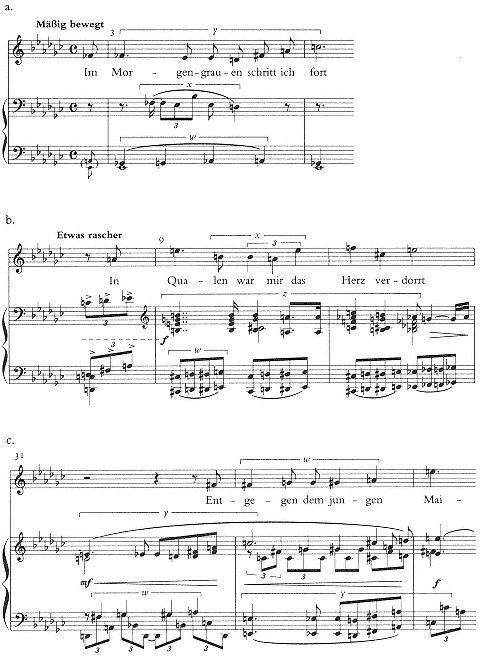
Example 8.1
Verlassen, op. 6, no. 4.
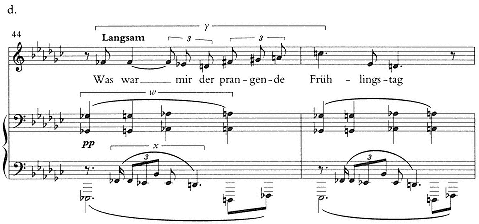
Example 8.1
continued
The intensity of the motivic working, the emphasis on invertible counterpoint at thematic returns, and the large role played by vagrant chords all mark Verlassen as a significant precursor of the D-Minor Quartet. A still more immediate precedent is another string quartet in D minor, which was to remain incomplete. This prior D-minor quartet, perhaps begun as early as 1901, but worked on most intensively in 1903-4,[3] is first alluded to by Egon Wellesz, who notes that in the summer of 1903 Schoenberg was working on "a string quartet which may be regarded as the predecessor of the D minor, Op. 7" (Wellesz 1925, 18). This must be a reference to the movement in D minor and a scherzo in F major, which are sketched intensively alongside op. 7 in the early portions of the so-called Sketchbook I, first used in the spring of 1904.[4] In addition to these sketches, there survives a fully scored draft of eighty measures of the opening movement, evidently begun as a fair copy (printed in SW A20: 219-25).
This torso provides important evidence of Schoenberg's compositional devel-
[3] Sketches for it appear in a pocket sketchbook used intermittently by Schoenberg between 1901 and 1908. See the discussion by Schmidt in SW B20: 279-84, who suggests (279) a starting date of 1901 for the fragmentary D-minor quartet because sketches for it are to be found among some for the Brettl-Lieder. Stylistically, however, the quartet fragment would seem to belong more to 1903.
[4] Schoenberg's sketchbooks from the period 1904-16, now in the archives of the Arnold Schoenberg Institute in Los Angeles, were first mentioned by Wellesz (1925, 19-20). They were described in greater detail in 1959 by Josef Rufer (who called them Sketchbooks I, II, and III, a practice I shall follow in this study), and in 1972 by Jan Maegaard (Rufer 1962, 126; Maegaard 1972, 1: 20-21). The most definitive and complete account, including detailed bibliographic descriptions, is that prepared by Schmidt for SW. See SW B3: 21-23 (Sketchbook I); B11/II: 1-5 (Sketchbook II); and B11/II: 6-7, 82-90 (Sketchbook III).
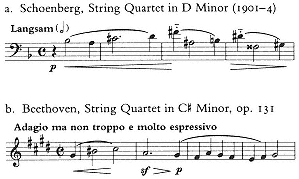
Example 8.2
Comparison of Fugue Subjects.
opment in instrumental forms between Pelleas und Melisande and the quartet that became op. 7. It is a slow, highly chromatic double fugue in which two subjects are presented independently and then combined.[5] Although no material was taken over directly from the earlier D-minor effort into op. 7, Wellesz was right to consider one a "predecessor" of the other. Schoenberg did incorporate a slow, chromatic fugue into op. 7—not at the opening, but as the transition to the second group of the first movement. In fact, the initial fugue subject of op. 7 bears certain striking similarities to the subject of the earlier D-minor fugue (cf. ex. 8.2a and motive b of ex. 8.3). Both are in duple dme and begin with a syncopated figure; both contain a pair of prominent downward leaps (minor sixths in the earlier fugue, diminished fifths in op. 7), followed by an upward semitone resolution.
The D-minor fugue subject not only anticipates the op. 7 transition; it also looks back to the most renowned nineteenth-century precedent for a fugal opening in a string quartet, Beethoven's Quartet in

[5] The fugue is analyzed in some detail, with transcriptions, by Schmidt in SW B20: 290-303. It is also discussed in Hattesen 1990, 167-90.
his op. 7.[6] The Beethoven quartet was obviously very much in his mind's ear as he worked toward, and on, op. 7 in the years 1903-4.
The first two bars of the earlier D-minor subject also hint at Schoenberg's characteristic interest in symmetrically arrayed tonal relationships. The dominant is decorated by the upper neighbor,






It is not clear either why Schoenberg abandoned work on the earlier D-minor quartet or what larger shape that work would ultimately have taken. Perhaps the massive double fugue came to seem too cerebral an opening for a quartet, even one by so committed a contrapuntalist as Schoenberg. In any case, in the spring of 1904, Schoenberg began work on the quartet that was to become op. 7 and was to occupy his energies on and off for a year and a half. In later years, Schoenberg would view this composition as representing a significant new direction in his musical development. He explained in 1949:
Thereafter [after Verklärte Nacht and Pelleas] I abandoned program-music and turned in the direction that was much more my own than all the preceding. It was the First String Quartet, Op. 7, in which I combined all the achievements of my time (including my own) such as: the construction of extremely large forms; greatly expanded melodies based on a richly moving harmony and new chord progressions; and a contrapuntal technique that solved problems offered by superimposed, individual parts which moved freely in more remote regions of a tonality and met frequently in vagrant harmonies.
RAUCHHAUPT 1971, 36
Although these remarks, as well as the D-Minor Quartet itself, would seem to signal a firm return to "absolute" instrumental music, Schoenberg would also allude frequently in later years to a "secret program" for op. 7 (see Bailey 1984, 130; Schmidt 1986, 230). When editing the quartet for SW, Schmidt discovered the outline of such a program on the inside cover of Sketchbook I; there can be
[6] See Schoenberg's notes for the first recordings of his own string quartets, prepared in 1936 (Steiner 1978, 132-33). Schoenberg also mentions Beethoven's quartet in typed notes for a lecture given at the University of Southern California in the 1930s.
little doubt that it refers to op. 7.[7] This program constitutes neither a poem nor a story line, as in Verklärte Nacht and Pelleas, but rather a succession of feelings or moods, which, as both Schmidt and Mark Benson have suggested (Benson 1987), can be matched with some precision to portions of op. 7, especially in the scherzo, for which the first sketches in Sketchbook I are marked "Neues Leben fühiend," a phrase that also appears as part of the program outline.
Large-Scale Form and Thematic Process
Although the secret program is obviously not without significance for an understanding of op. 7, the real importance of the work lies in its relationship to, and transformation of, the absolute instrumental tradition of the eighteenth and nineteenth centuries. The D-Minor Quartet was unquestionably Schoenberg's most thoroughgoing attempt up to that date to compress and interweave into a continuous composition the standard three or four movements of an instrumental cycle, or, as he himself put it, "to include all the four characters of the sonata type in one single, uninterrupted movement" (Rauchhaupt 1971, 36). Schoenberg's quartet goes much further in this direction than Richard Strauss's tone poems or earlier nineteenth-century predecessors like Schubert's "Wanderer" Fantasy, Liszt's B-Minor Piano Sonata, and Schumann's Fourth Symphony. In each of the latter three works, the movements or sections succeed each other without pause (or with only a short pause); in each, there are clear thematic relationships between the movements; in each, the larger scheme is modified according to principles of sonata form, in that the first movement recapitulation is suppressed and its function largely taken over by the finale. Schoenberg does all this and more.[8]
The overall form of Schoenberg's D-Minor Quartet is outlined in table 8. The following description corresponds closely to Schoenberg's own prose analyses, which, significantly, invoke only the thematic dimension of "sonata form," not
[7] The program is transcribed in SW B20: 109-10, and in Schmidt 1986. It also is included, in the original German and in English translation, in the booklet accompanying the 1987 reissue on compact discs of the La Salle Quartet's Neue Wiener Schule: Schoenberg, Berg, Webern (DG 419 994-2). This booklet is a reformatted and in some respects abridged version of Rauchhaupt 1971; the recently discovered program for op. 7 appears on pp. 18-19 (German) and 236-37 (English).
[8] In his "Notes" of 1949, Schoenberg also suggests that the first movement of Beethoven's Eroica Symphony served as an important "model" for the "great expansion" of op. 7 (Rauchhaupt 1971, 36, 39). This tantalizing remark refers, I think, not to any large-scale formal principles, but to techniques of thematic and motivic development. Dika Newlin, taking Schoenberg at his word, has attempted to demonstrate specific similarities between some of the Eroica themes and those of op. 7 (Newlin 1978, 227-29); the analysis seems contrived and seems also to misintepret the broader kind of "modeling" to which Schoenberg was probably referring. Despite Schoenberg's mention of the Eroica as specific model, I feel that attempts to find any one-to-one relationship are misguided. (At least up to this point I have not seen or read any persuasive accounts.)
| ||||||||||||||||||||||||||||||||||||||||||||||||
the harmonic one.[9] The first "movement" is comprised of a sonata-form exposition, development, and varied recapitulation. Then follows a full-fledged scherzo-trio-scherzo. The varied reprise of the scherzo functions as a continuation or resumption of the development, which begins with thematic material from the scherzo and then (at H ) takes up material from the first group of the first movement. The development leads into a more literal recapitulation of the main theme on the tonic, then a dramatic "liquidation."
A long fermata marks the principal large division of the quartet. The tripartite slow movement opens with essentially new thematic material, which is gradually permeated by recollection of secondary themes from the first movement. This process is analogous to the infiltration of the scherzo reprise by first group themes in the first half of the quartet. Just as that process led up to recapitulation of the first group, so this one leads (at L 52) to a recapitulation of the second group. The rondo finale theme is fashioned as a transformation of the slow movement theme; the contrasting episodes are all built from earlier themes. The coda, based on the opening and transition theme, functions as a conclusion to both the larger four-movement plan and the individual sonata-form plan.
Neither a diagram nor a verbal synopsis can do justice to the richness of op. 7, a work that, as Adorno claimed, "down to its last note . . . created an entirely new level of thematically coherent chamber-music composition" (Adorno 1981, 157). Something of the thematic-formal process that seems to generate the larger structure before our very ears can be sampled across the 300-measure segment comprising the transition, second group, first development and recapitulation, and scherzo. The transition is one of the least tonally oriented passages in the entire quartet (and in Schoenberg's music up to this point). A fugato based on a highly chromatic subject, it is almost pure counterpoint, pure "theme." First stated in full at the second entry, by the second violin, the subject has three related components or motives, labeled a, b, and c in ex. 8.3. (As will be shown below, in an examination of the sketches, these labels are in fact Schoenberg's own.) Subject b freely inverts the opening leap of a, then continues with a similar ascent
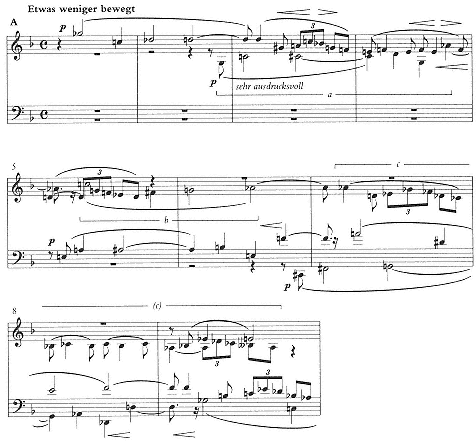
Example 8.3
First String Quartet, op. 7, transition.
through two half-steps. Subject c, rhythmically more animated, begins like a diminution of b, with the downward leap of a diminished fifth and ascent of a half-step. Its second measure contains what is to become an important syncopated figure oscillating within a half-step. The fugato opens with the b subject in the first violin; all subsequent entries employ a, b, and c in order.
The main theme of the second group of the exposition (ex. 8.4a) is derived directly from the transition material. The principal melodic line, in the first violin, is a rhythmically augmented version of the oscillating, syncopated seconds of motive c. The bottom part, at first played in parallel thirds by the viola and cello, takes over the first four notes and the rhythm of motive b (at a different transposition). In the continuation of the second group, Schoenberg fashions a magical transformation in E minor of the c -derived figure, which is now given a
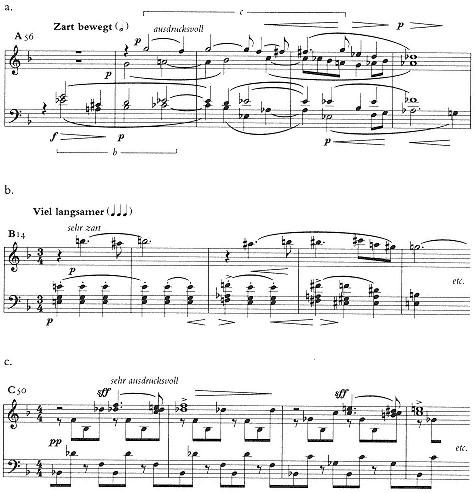
Example 8.4
First String Quartet, op. 7, second group and transformations.
pulsating homophonic accompaniment (ex. 8.4b). In the first recapitulation, this theme appears in yet another homophonic transformation, now(in


Example 8.5
First String Quartet, op. 7, scherzo.
basic material is less "developed," less pulled apart, than it is placed, more or less intact, into a new rhythmic, textural, and harmonic context.[10] The transformations in op. 7 show clearly how Schoenberg seeks to link his work with nineteenth-century models, despite a style that is at other moments relentlessly developmental and modern.
The final part of the first recapitulation is occupied by energetic working of the transition theme and an extraordinary modulation from the dominant of F to that of





The First Group: Thematic Aspects
In the discussion up to this point, I have concentrated on what might be called the higher-level thematic process, which shapes the broader segments of the form. The quartet is as intensely "thematic" on the more local level, as can be seen in the first group (mm. 1-96; first portion reproduced in Appendix ex. Q). The later Schoenberg, even the composer of the First Chamber Symphony of
[10] On the basic distinctions between thematic transformation and development, see Frisch 1984, ch. 2, and Friedheim 1963, 13–14.
1906, would undoubtedly have deemed excessive the first group's duration of two and a half minutes and the numerous varied repetitions of the main theme; but for the Schoenberg of 1904, such breadth was necessary to assure the comprehensibility and memorability of the basic thematic material of the quartet.
The structure of the first group is a fascinating hybrid or interweaving of what might be called strophic form, in which the main theme is subjected to successive variation, and ternary form, which has a contrasting middle section. (We have seen how Schoenberg used ternary form for the first group of the first movement of his D-Major Quartet [chapter 2] and how he modified it for many of the thematic statements of Verklärte Nacht [chapter 5].) Emphatic statements of the main, or A, theme are placed like pillars at roughly thirty-measure (or, in real time, fifty-second) intervals: A (m. 1). A' (m. 30), A" (m. 65). This structure comprises the strophic aspect of the first group. But A' also serves to some extent as a contrasting middle section in that A and A" begin firmly in the tonic, D minor, while A' contains statements of the theme outside (literally, around) the tonic, in


Another ternary aspect of the structure of the first group is suggested by the contrasting (but related) material beginning at m. 14, in the key of

As was pointed out long ago by Berg in his renowned essay on Schoenberg's quartet, the opening "theme" of op. 7 actually consists (as in the song Verlassen) of three separate lines, which come to be treated independently (Reich 1965, 199).[12] This opening thematic complex (Appendix ex. Q) extends thirteen measures and consists of two related segments, which we can call x (m. i through beat 3 of m. 8) and y (beat 4 of m. 8 through 13). (Measures 7-8 are really transitional, serving both to continue elements of x and to introduce the sixteenthnote motion that is characteristic of y.) In the areas of phrase structure and metricrhythmic manipulation, this thematic complex goes well beyond opp. 4 and 5.
Berg analyzed what I call x1 as comprising two phrases of two and a half mea-
[11] This embedding of formal structures within one another is discussed by Michael Cherlin in a stimulating unpublished study, "Formal Problems in Schoenberg's First String Quartet," prepared as a seminar paper at Yale University in 1980. I am grateful to Professor Cherlin for sharing his essay with me.
[12] Berg's essay, "Warum ist Schönbergs Musik so schwer verständlich," first appeared in 1924 in a special issue (Sonderheft) of the Viennese journal Musikblätter des Anbruch, devoted to Schoenberg (Arnold Schönberg zum fünfzigsten Geburtstage). It has been translated three times: in Music Review 13 (1952): 187-96; in Reich 1965, 189-204 (from which my citations are taken); and in Rauchhaupt 1971, 20-30.

Example 8.6
Berg's analysis of the main theme from Schoenberg's First String Quartet, op. 7 (from Reich 1965, 191).
sures each (ex. 8.6); he pointed with admiration (as his teacher Schoenberg would do to themes in Brahms) to Schoenberg's avoidance of the conventional two- or four-measure unit. In fact, the structure is more intricate than Berg suggests. The basic phrase cannot be said to end in midair on the D of m. 3, as Berg's parsing suggests, but on the low E that follows. Such an interpretation—of the E as the conclusion of the phrase—is borne out by the slur linking the D and E (in the real score) and by the diminuendo across beats 2–4 of m. 3.[13]
And yet there is an important element of accuracy in Berg's analysis. Classicalromantic practice would lead us to expect a second phrase beginning on the low E, the note that corresponds in duration and in register to the D of m. I. A second or consequent phrase built as a sequence of the first and beginning on the supertonic degree is a time-honored device for opening themes (for example, the first Allegro theme of Beethoven's First Symphony, or of Brahms's Second). In his cheeky rewrite of Schoenberg's theme, intended to smooth out the irregularities, Berg puts it in exactly such a form: two two-measure phrases, the second beginning on the second degree (Reich 1965, 193). (Even here, however, there is overlap, since the E is still heard as conclusion to the first phrase.) Schoenberg is clearly playing upon such an expectation here: the note E remains tantalizingly ambiguous, both an ending and a beginning. In this sense it functions like section A' of the first group, looking both backward and forward.
Each of the two lower elements of the theme falls into a phrase structure (and relationship to the notated bar line) different from x1 . The viola part, x2 , unfolds in regular one-measure units. The bass, x 3 , consists, like x 1 , of two essentially sequential phrases, but the second phrase (up a minor third from the opening pitch D) begins in beat 2 of m. 4, well after the beginning of the second phrase of x1 . Thus, the second phrases of 1 and x3 lie differently with respect to each other than did the first phrases.
By m. 6 the original metrical alignment of x1 is restored: the dotted figure DE is now in its original position on the fourth beat (like the

[13] For further discussion of the structure of this theme and of its genesis as reflected in the sketches for op. 7, see Frisch 1984, 165-69.
7 all parts begin clearly and emphatically on the notated downbeat with what is the first real development of x material. As Berg plausibly suggested, the top line here is like a compressed version of x1 (Reich 1965, 192). Now the elusive pitch E is fully integrated into the theme. The bottom line is clearly a variant, in dotted rhythm, of the portion of x3 that descends from the

After this measure, Schoenberg builds to the climax of the A theme by introducing essentially new material (hence y). Each of the three elements is distinct from what has preceded it: the top line (y1 ), in which an essentially stepwise descent (

Unlike a conventional contrasting B section in a ternary group, B begins in m. 14 almost as if resuming the development of x, which has been interrupted by y. The top part seems to pick up rhythmically in the second measure of x1 as does the bass in the second measure of x3 . The viola line has the rhythm and the tremolo of x 2 , but the pitch structure of x3 . Just as the first half of B is a recollection or development of x, so too its continuation in mm. 19-24 is clearly based on y. The chromatically descending line y1 y is now augmented to quarter-note triplets; the sixteenth-note quintuplets of y2 y have become eighth-note ones. Only at the very end of B, with the "etwas langsamer" theme of m. 24, does Schoenberg introduce genuinely contrasting material (z); this, however, gives way almost immediately to A'.
In A' the original x returns, but with its outer parts inverted: x1 is now the bass, x3 the melody. In its eighth measure, the restatement of x veers away from its initial form into an extended contrapuntal development of material from A (x,y, and z) y and B. The arrival of the A theme in D minor at m. 65, with its components in their original position (x1 on the top, x3 on the bottom) signals the real return within the first group; because of the extensive development that has preceded in A', the return is especially forceful. It leads to a full liquidation of A material.
The First Group: Harmonic Aspects
The thematic process of the first group rides on the surface of, and of course helps to generate, a chromatic harmony that is no less volatile. In his 1924 essay Berg presents a harmonic skeleton of the first ten measures of op. 7 in what he calls "chorale style" (ex. 8.7). He attempts to show that despite the profusion of chords that occurs within a short space, all represented in half notes in his example, "there is no single sonority, not even on the unaccented semiquavers
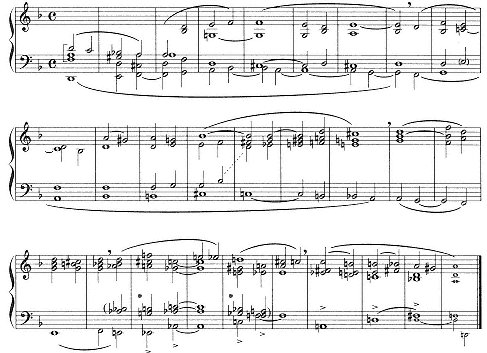
Example 8.7
Berg's "chorale" or harmonic reduction of the first theme of Schoenberg's First String Quartet, op. 7 (from Reich 1965, 197).
[eighth-notes] of these ten quartet bars, that cannot be immediately clear to any car educated in the of the last century" (Reich 1965, 198). As Christopher Wintle has shown, many of the verticalities in Berg's chorale can be explained along the lines of Schoenberg's own Theory of Harmony as chromatic alterations of certain basic chords (Wintle 1980, 52-55). And although, as Wintle also suggests. Berg's harmonies are sometimes dubious representations of what seems actually to be happening in the music, the chorale nevertheless offers a good starting point for an assessment of the local-level harmonic component of op. 7.
One of the striking things about the quartet-and this is readily apparent at the opening-is the avoidance of functional dominants on the small scale and the concomitant pervasiveness of vagrant harmonies. Berg's chorale displays a dominant-seventh harmony across (his) mm. 5-7; although the harmony is somewhat obscured by the motion of the voices, it is explicit in the first half of
m. 6 and throughout m. 7. In the actual piece, this dominant is even less apparent, and less structural. Although the A in the bass on the last eighth note of Schoenberg's m. 2 supports a


The harmonic goal of the first phrase is not the elusive dominant, but the



Across the A portion of the first group, Schoenberg's strategy seems to be to increase the level of dissonance and chromaticism progressively. The






The two-beat silence of m. 10 is shattering in effect: the musical discourse seems paralyzed or frozen by the disorienting harmonic-thematic spiral of theme y. The shock is then intensified, rather than dissipated, by the sequential repetition of y up a major third (and now fortissimo). The use of exact sequence (it is exact up to m. 12) is rare in Schoenberg's works after 1900, and is especially strik-

Example 8.8
First String Quartet, op. 7, alternation of whole-tone and seventh chords in mm. 8–10.

Example 8.9
Derivation and resolution of six-note whole-tone chord, from Schoenberg 1978, p. 392 (ex. 323).
ing in view of the negative opinion he often takes of it in his writings (see, for example, Schoenberg 1975, 129-31). Here the sequence seems specifically intended to exaggerate or prolong the disruption represented by y.
The combination of vagrant harmonies with fifth motion in the bass is reminiscent of certain works of 1899 and 1900, especially the song Jesus bettelt from op. 2 (see chapter 4) and Tove's"Du sendest mir einen Liebesblick"from Gurrelieder (see chapter 6). However, the whole-tone complex now plays a greater role, and does so in a way that has important implications for Schoenberg's compositional language in 1904-5. In op. 7, Schoenberg does not treat the whole-tone scale/chord as a purely symmetrical, rootless phenomenon. It is used less to weaken or loosen tonal implications than to intensify chromatic and vagrant harmonies. By resolving the whole-tone harmonies of mm. 8-9 emphatically up by fourth, as if they were dominant chords, Schoenberg seems to stress their functional aspect.
It is essential in this context to consider Schoenberg's discussion of whole tones in Theory of Harmony, where a chord containing all six notes of the whole-tone scale is derived from a dominant ninth, by "simultaneously raising and lowering the fifth"(Schoenberg 1978, 392). This ninth chord is then resolved by fifth, like a normal dominant, as in ex. 8.9. This resolution can be compared with those in theme y of op. 7, as shown in the first four chords of ex. 8.8. (In ex. 8.8 the
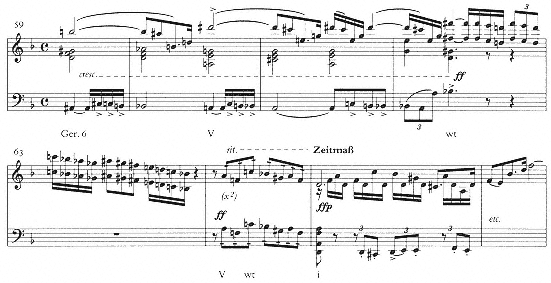
Example 8.10
First String Quartet, op. 7, transition to return of main theme (A").
whole-tone chords are represented with four, not six, notes; but, as suggested earlier, all six notes of the scale are in fact sounded in the music, where the effect and function are similar to Schoenberg's Theory of Harmony example.) This rootoriented view of even the most vagrant chords is fully characteristic of Schoenberg. As with any chord discussed in Theory of Harmony, he stresses the way in which the whole-tone sonorities are to be resolved and linked with other harmonies. In this respect he contrasts his own early compositions with those of his contemporaries:
Debussy uses this chord and scale more in the sense of impressionistic expressive devices, somewhat as a tone color (so does Strauss in Salome); but they entered my work more for the sake of their harmonic and melodic possibilities: the chords for the sake of their connection with other chords, the scale for the sake of its peculiar influence on the melody.
SCHOENBERG 1978, 393
The role of the whole-tone complex in op. 7 as intensification, rather than dissolution, of diatonic-chromatic relations is reinforced at the transition to A" in the first group (ex. 8.10). After the imitative statement of the main theme beginning on

chord like a German sixth on




The whole-tone scale breaks off abruptly in m. 63; the reappearance of the main theme in D minor is preceded in m. 64 by a transitional measure identical with the first measure of x2 (see ex. 8.10). Schoenberg's use of this thematic fragment as a transition is a masterstroke, for it serves genuinely to mediate between the preceding whole-tone scale and the subsequent D-minor return. Whole-tone elements are still present in the


Here we might do well to glance back at Berg's chorale (ex. 8.7), where the harmonic reduction of the second half of Schoenberg's m. 1 (the first half of m. 2 in the chorale) reveals a whole-tone chord of the French sixth type, with E in the bass. Berg's harmonic entity may not at first seem an accurate rendering of Schoenberg's music, since it freezes into a fictional simultaneity two pitches,


The whole process is a splendid example of the intimate, reciprocal relationship between the vertical and horizontal dimensions-between "harmony" and
[14] The relation of the whole-tone chord of m. 2 of Berg's chorale to that of m. 23 has been pointed out by Wintle (1980, 54).
"theme"—in the quartet. What begins as an apparently linear, thematic detail in the viola part of m. 1 becomes a harmonic element in the whole-tone sonorities of mm. 8-9, then evolves back into the former role with the whole-tone scale of mm. 62-63.
Sketches: The Genesis of Op. 7
Schoenberg was occupied with the D-Minor Quartet intermittently for over a year and a half, from the spring of 1904 to the fall of 1905. More sketches survive for this than for any other early work, and they bear separate consideration here for the richly detailed and suggestive—if not always easily decipherable—picture offered of how Schoenberg planned his most ambitious large-scale instrumental work to date. Perhaps the strongest impression gained from such a study is how intensively Schoenberg labored to create the dense web of thematic interconnections—what I have above called the large-scale thematic process.
With the exception of a handful of loose leaves, all the extant preliminary graphic activity for op. 7 is contained on almost 100 pages in the two sketchbooks (I and II) that Schoenberg used consecutively in the years 1904-6. In the critical report for the D-Minor Quartet in SW (B20: 1-13), Schmidt divides the material in the sketchbooks into two categories, a "first fair copy" (erste Niederschrift) and "sketches" (Skizzen). The former constitutes a nearly complete full-score draft of the work, although not a continuous one, since the music is distributed widely over the sketchbooks and sections are connected by Schoenberg with numerous "VI-DE" cross-references. (The final fair copy of the score, which served as Stichvorlage, is a separate autograph at the Library of Congress, dated 29 September 1905 at the end.) The latter category includes every other kind of musical jotting not part of the first fair copy.
On the whole, the sketchbooks bear out Schoenberg's own testimony about the composition of the quartet. In the essay "Heart and Brain in Music" (1947), he noted, "I personally belong to those who generally write very fast, whether it is 'cerebral' counterpoint or 'spontaneous' melody" (Schoenberg 1975, 55). He implies that this was the case with the composition of the D-Minor Quartet: "Some forty years ago I was composing my First String Quartet, Op. 7. Usually taking morning walks, I composed in my mind 40 to 80 measures complete in almost every detail. I needed only two or three hours to copy down these larger sections from memory" (ibid., 61).
These "larger sections" would correspond to what Schmidt has called the first fair copy (although neither he nor Schoenberg accounts for why these sections appear so scattered, and their sequence so jumbled, in the sketchbooks). But in addition to these segments, the sketchbooks contain several smaller fragments, usually of only a few bars, in which Schoenberg is clearly engaging less in active
| ||||||||||||||||||||||||||||||||||
"composition" than in reflective or exploratory work. Following Alan Tyson's term for certain of Beethoven's similar jottings, we may call these "concept" sketches (Tyson 1970, 68-69), although it is important to note (and will be shown) that Schoenberg's concept sketches tend to appear in coherent groups, while Beethoven's are usually more isolated. If we assume that the order of the material as set down in the sketchbooks for the most part represents the order in which Schoenberg conceived or drafted it—and I think it is reasonable to do so, since the books were bound before any entries were made—then a fascinating sequence of creation emerges. Table 9 shows the position of these concept sketches within the sketchbooks and their relation to the formal scheme outlined in table 8.[15] Pages with the most significant concept sketches are indicated in italics. These represent what I believe to be the "crisis" points in Schoenberg's draft-
[15] The dates given in table 9 are taken from Schoenberg's own annotations in the sketchbooks. When referring to a particular sketch, I shall for the convenience of the reader provide a reference to the transcription in SW, including (in brackets) the "S" number assigned by the editor, Schmidt, to each sketch. My own readings occasionally differ in details from Schmidt's.

Example 8.11
First String Quartet, op. 7, sketch for scherzo theme, in Sketchbook I, p. 31.
ing of the quartet, moments at which the generally smooth flow of composition was interrupted.
After working out much of the first group on ¼-17 (Sketchbook I, pp. 4-17), Schoenberg set aside the quartet to work on other projects, principally the songs that were to become op. 8.[16] Some fourteen pages later, he returned to op. 7, but did not, as we might expect, pick up where he left off, in the first group. He began instead to sketch the scherzo theme, well in advance of its eventual appearance. The theme appears in short score in the key of

Schoenberg attempted no larger draft of the scherzo at this point, but began instead to work immediately on the second group, another step backward to his previous stopping point. The first concept sketches appear in short score on the following page, 1/32;[17] the sketches for the second theme are partially transcribed in ex. 8.12 (SW B20: 52-53 [S22-23]). In its initial form, ex. 8.12a, the theme makes no apparent reference to motives b and c; the principal melody and the bass part lack the syncopation characteristic of these motives. Schoenberg thus seems to work more from a harmonic skeleton than from a fully thematic conception. Directly beneath this sketch, however, Schoenberg in effect "thematicizes" the same passage (ex. 8. 12b). The top line is now much closer to c; the bass syncopation, which derives from motive a, is added in the margin of the sketch leaf and thus appears to be an afterthought. It was most likely tacked on some-
[16] This would have been in mid July 1904. In a letter to Oskar Posa written on 13 July, Schoenberg notes that he has begun a new orchestral song and has set aside the quartet for the time being: "Mein Quartett ruht. Vielleicht komme ich aber doch noch dazu" (cited in Szmolyan 1974, 193.)
[17] A facsimile reproduction of this sketch page appears in Frisch 1988a, 300.
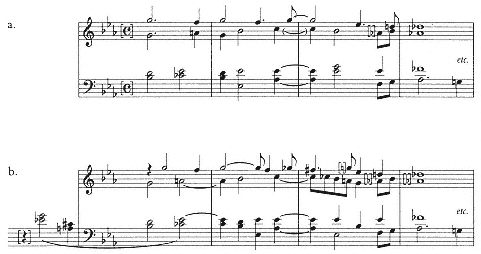
Example 8.12
First String Quartet, p. 7, sketches for second group, in Sketchbook I, p. 32.
what later, after Schoenberg had continued his conceptual path back through the exposition of the first movement.[18]
Schoenberg now abandoned the second group to work on the transition. First he jotted down in a very light pencil the scherzo theme itself, in triple meter and still (by implication) in the key of

[19] A similar phenomenon is to be found in the sketches for the First Chamber Symphony, op. 9, in Sketchbook II. In the midst of sketches for the development section, Schoenberg wrote out the first two measures of the secondary theme of the exposition (mm. 84-85). Schmidt suggests plausibly that this jotting represents an aide-mémoire (Gedächtnisstütze), since the head motive of this theme plays an important role in this particular passage of the development (SW B11/II: 65).

Example 8.13
First String Quartet, op. 7, sketch for transition theme, in Sketchbook I, p. 32.

Example 8.14
First String Quartet, op. 7, sketch for motive b, in Sketchbook I, p. 33.
and in something like the chromatic form it would assume in the transition. Motive b, however, still ascends by whole step,

On the next page of the sketchbook, I/33, Schoenberg began to sketch the transition in earnest by separating and actually labeling the component parts of the transformed scherzo theme, a, b, and c.[21] At the upper left of the page, we find motive b isolated (ex. 8.14; SW B20: 44 [S24]). This is very much like the b subject of the actual transition, beginning within the syncopation and the downward leap of a diminished fifth. But in the disjunct leaps of the continuation (


On the remainder of this page, we see the "cerebral" Schoenberg trying out various three-part combinations of the motives in four more short sketches.[22] At
[20] In S19, Schmidt mistakenly interprets the E in m. 4 of the sketch as a natural; the accidental preceding it is clearly a flat.
[21] A facsimile reproduction of this page appears in Frisch 1988a, 301.
[22] For transcriptions of these sketches, see SW B20: 45-48. Related sketching activity for the transition-in which Schoenberg tries out various combinations of the motives labeled a, b, and c,- is found on two loose leaves and in a pocket sketchbook, which must have been used concurrently with Sketchbook I. These sketches are transcribed in SW B20: 44-51. In one sketch (S134), Schoenberg wrote out the scherzo theme in its original form, apparently again as an aide-mémoire.
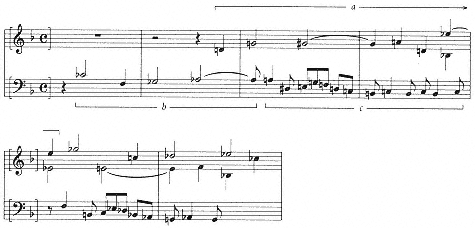
Example 8.15
First String Quartet, op. 7, sketch for transition, in Sketchbook I, p. 33.
some point during, or soon after, his work on this page—that is, after isolating motive b— Schoenberg turned back to 1/32 and added the syncopated measure in the margin for the bass part of the second theme (above, ex. 8.12). He thus tightened the net of thematic associations between this theme, the transition, and the scherzo still further. He also confirmed the final form of motive b, with ascending semitones (here

In his critical and theoretical writings Schoenberg often stresses that a motivic or thematic idea must have generative power—that all the events of a piece must be implicit in, or foreseen in, the basic shape, or Grundgestalt, presented at the opening.[23] In some of the exercises in his textbook Fundamentals of Musical Composition, he shows student composers how to elaborate an initial motive into an entire small work (Schoenberg 1967, 64-67). The transition, second group, development, and scherzo of the D-Minor Quartet can be heard as an extremely sophisticated example of this process on a massive scale. But the series of sketch pages (I/31-33) we have just examined suggests that the hearing and the making were hardly as congruent as Schoenberg's textbook (or his own statements on the creative process) might suggest. The "basic shape" from which Schoenberg forged this particular complex of thematic material was the scherzo theme. The
[23] See, for example, his remarks in the essay "Linear Counterpoint," where he postulates:" 'Whatever happens in a piece of music is nothing but the endless reshaping of a basic shape.' Or, in other words, there is nothing in a piece of music but what comes from the theme, springs from it and can be traced back to it; to put it still more severely, nothing but the theme itself. Or, all the shapes appearing in a piece of music are foreseen in the 'theme'" (Schoenberg 1975, 290).
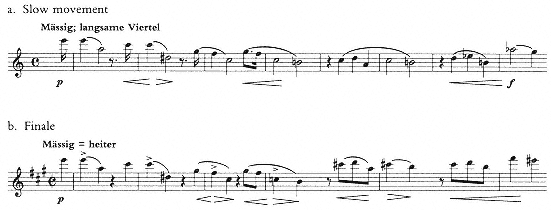
Example 8.16
First String Quartet, op. 7.
compositional process appears to have involved a gradual chromaticization of a diatonic scherzo theme into the transition theme—a process that is then reversed in the actual quartet, where the scherzo is made to serve as the culmination, rather than the germination.
With these three pages of concept sketches, Schoenberg resolved many of the problems of creating a thematically integrated and continuous form. He now returned to the first group and, on I/34-II/16, wrote out an extensive and more or less continuous draft of the entire first half of the quartet, through the trio. The matter of thematic and formal logic arose again, however, as Schoenberg planned the second half of the quartet. As table 9 suggests, the steady flow of composition came to a halt on II/16, at the beginning of the passage that was to serve as both scherzo recapitulation and second development. Schoenberg had here to reconcile two demands: that of the larger sonata-form design, which necessitated the further development of earlier material, and that of the individual movement, which required a symmetrical restatement of the scherzo theme.
He also began to think—or at least set down the first evidence of that thinking—about the shape that the latter part of the quartet would take. Here as well there were potentially conflicting demands. A slow movement and finale had to have sufficient independence as movements; yet to fulfill their role in the larger sonata-form design, they had also to recapitulate earlier material. Schoenberg's ultimate answer was to fashion the main theme of the slow movement of op. 7 (ex. 8.16a) as essentially new material. Unlike the scherzo, it does not grow out of or emerge from any obvious thematic process. Indeed, the slow movement comes as a distinct contrast or relaxation after the recapitulation and intense liquidation of the first theme. The main theme of the finale is virtually a Lisztian
transformation of the slow movement, whose first six measures are taken over note for note (ex. 8.16b).
This ingenious formal and thematic design was anything but obvious to Schoenberg when he was at II/18 of the sketches, as he broke off a tentative attempt at the scherzo recapitulation to draft a slow movement (see ex. 8.17; the sketch is fully transcribed in SW B20: 78-79 [S75]). This fragment, in the key of






Schoenberg's mind turned now to the last movement. Directly beneath this slow movement fragment, we find the first sketches for the finale theme. There are three, one above the other (excerpted in 8.18a, b, c; SW B20: 87-88 [S77-79]). The first, in A major, has lithe, energetic eighth notes. The second, still in A, slows down the motion and eliminates the melodic diminution; the theme now has also the beginnings of an accompaniment. The third sketch transposes the second to D major, the tonic of the work as a whole. In ex. 8.18b and c, the theme is quite close to its final form, except for the contour of the opening three-note figure, which here is a transformation of motive b, a descending leap followed by a chromatic ascent. As in the preceding draft of the slow movement, then, Schoenberg was deriving his thematic material exclusively (and audibly) from the first movement of the quartet. But this logical chain of thematic associations did not satisfy him. Indeed, he may have felt that he had linked that chain too tightly, that his quartet lacked enough genuine contrast.
He broke off these concept sketches for the finale and, on the next page, II/21, began a draft in full score of the slow movement as we now know it. Its theme is clearly related to the finale theme just sketched, but any direct association with motive b has been eliminated. The opening three-note figure now repeats the first note and leaps down a fifth. It is thus essentially new thematic material. When
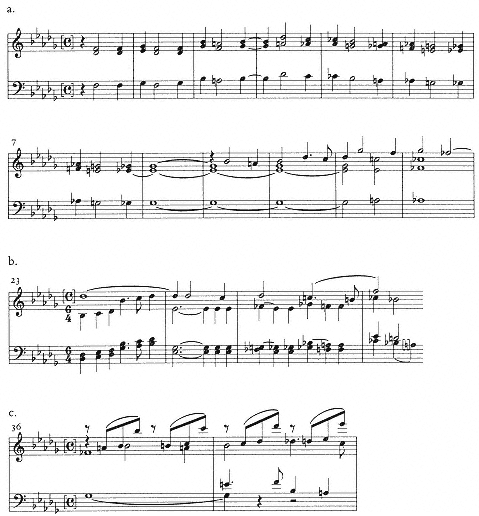
Example 8.17
First String Quartet, op. 7, draft for slow movement, in Sketchbook II, pp. 19–20 (reduction).

Example 8.18
First String Quartet, op. 7, sketches for finale theme, in Sketchbook II, p. 20.
Schoenberg came to write out the draft for the finale, beginning on II/42, he began to write the theme out as in ex. 8.18c, but then crossed out that version and rewrote the theme to bring it into conformity with the slow movement (see SW B20: 89-90 [S94]). As already demonstrated, the finale became an almost literal transformation of the slow movement.
Establishing this relationship between the slow movement and finale was, I believe, the last major conceptual problem Schoenberg encountered in planning the D-Minor Quartet.[24] He had found a way to give the second half of the quartet
[24] The autograph score of the quartet, however, is far from a clean copy. It contains numerous revisions, most notably large cuts in development 1 and recapitulation 1 (see SW B20: 101-9).
(the portion after the fermata) its own thematic integrity or identity without abandoning its purely recapitulatory function in the larger sonata design.
That Schoenberg decided to cast the finale theme in A major, and not in D, as in the third of the concept sketches (ex. 8.18c), is highly suggestive from the viewpoint of large-scale tonal planning. Very much as in Verklärte Nacht and Pelleas, he was faced in the latter part of the quartet with the challenge of reestablishing the tonic by means of the kind of dominant relationships that had been largely absent up to this point. One way of generating dominant tension was to place the rondo theme in the key of A.
In fact, however, in none of its three main appearances (indicated by A, A', and A" in movement IV of table 8) does the rondo theme resolve directly to the tonic. The magisterial coda of the quartet may be said to assert, rather than achieve, D major. The coda is certainly successful on its own terms, but its effect is different from a conclusion that grows out of extensive dominant preparation. One suspects that for Schoenberg, placing the rondo theme of op. 7 in the key of the dominant was something of a gesture toward a compositional procedure he no longer could or would easily follow. In the next chapter, we shall consider a very similar gesture, one that also seems to have generated uncertainty on the composer's part, in the B-major slow segment near the end of the First Chamber Symphony.
Schoenberg and Reger: A Brief Comparison
In chapter 1 it was suggested that among the younger Brahmsians of the 1890s, Max Reger came the closest to Schoenberg in his assimilation of and response to the compositional techniques of Brahms. By 1904 both composers had moved well beyond overt imitation or emulation; basic Brahmsian precepts, such as dense thematic-motivic development and flexible phrase structure, were now put in the service of highly individual chromatic languages. Yet there remain strong and instructive points of contact between the styles of Reger and Schoenberg. These are perhaps especially apparent in the string quartets in the same key, D minor, written by both composers at this time.
Reger's D-Minor Quartet, op. 74, completed and published in 1904, just as Schoenberg was working on his own op. 7, is one of his most imposing and ambitious pieces of chamber music, lasting almost an hour in performance.[25] It would be impossible to prove any direct impact of the Reger work upon Schoenberg, who at any rate began work on op. 7 before he could have encountered
[25] The timings given in Stein 1953, 139, total 58': I, 24'; II, 4'30"; III, 19'30"; IV, 10'.
Reger's work (which appeared in the summer of 1904). Yet during the protracted composition of his own op. 7, Schoenberg may well have become familiar with, and interested in, Reger's op. 74.
The circumstances are as follows. Reger's quartet was to have been premiered at the annual Tonkünstlerfest of the Allgemeiner Deutscher Musikverein in Frankfurt in May 1904, but because of the illness of one of the players, the performance was postponed until December in Frankfurt (Stein 1953, 608).[26] That same summer, Schoenberg and several Viennese colleagues formed the Vereinigung schaffender Tonkünstler (Society of Creative Composers) and were on the lookout for works to program in their first (and in the event, only) season. Reger himself joined the Vereinigung in July and agreed to participate as pianist (playing Bach transcriptions) in a concert on 20 February 1905.[27] As is apparent from the Vereinigung's concert program of 20 January 1905 (a copy is held at the Arnold Schoenberg Institute), plans were changed somewhat for the February concert, which was now announced to include the Reger D-Minor Quartet, op. 74. At the actual concert, however, the quartet was not performed; the Violin Sonata in C Major, op. 72, was substituted, played by Arnold Rosé and Bruno Walter. Reger himself was almost certainly present, as he was in Vienna on 19-20 February to participate in an all-Reger concert of the Ansorge-Verein (Schreiber 1981, 283).
It is well known that Schoenberg found much to admire in Reger's music. In 1918-21 he programmed numerous Reger works-indeed, more than by any other composer-in the concerts of the Society for Private Musical Performances (see Szmolyan 1981, 84-96); in his writings he would refer to Reger sympathetically (see, e.g., Schoenberg 1975, 129-30, 427). It is certainly possible that as Schoenberg resumed work on his quartet after a pause during the summer of 1904, and as he continued to labor over problems of large-scale structure in ways that we have examined above, Reger's op. 74, especially its first movement, provided a powerful model for the integration of sonata style and large-scale form.
Reger's movement, cast in sonata form without repeated exposition, and lasting nonetheless over twenty minutes, is surely one of the most massive composed at the turn of the century. Carl Dahlhaus has rightly characterized it as having "truly symphonic proportions" (Dahlhaus 1989, 339). Although it forms part of a piece of chamber music, the movement is really comparable in scope and duration to the sonata-form first movements of Mahler's Second, Sixth, and Sev-
[26] In the Schoenberg Collection at the Library of Congress there is an issue of the Mittheilungen of the Allegemeiner Deutscher Musikverein from May 1903, which announces Schoenberg as a new member of the society. There are also issues for August 1903 and for April and May 1904; the latter two announce the impending performance of the Reger quartet.
[27] Letters from Oskar Posa to Schoenberg, 12 July and 26 August 1904, Schoenberg Collection, Library of Congress.
enth Symphonies. In a contemporary assessment of Reger, the critic Max Hehemann suggested that the first movement of op. 74 stood as one of the composer's masterpieces because of its "exceedingly fecund invention both in the chiseled thematic working and the splendid architectonic structure" (Hehemann 1905, 416).
Like Schoenberg, Reger relies strongly on large and distinct thematic pillars to give definition to the sonata structure.[28] The design of Reger's expansive exposition can be represented as:
First group, D minor, mm. 1-68
theme 1a, m. 1
theme 1b, m. 6
1a, m. 10
1b, m. 15
1a, m. 29
transition, m. 34
1b, m. 49
1a, m. 55
Transition, mm. 69-90
Second theme, F major, mm. 91-116
Transition, mm. 117-38
Closing group,

Like many composers in the sonata tradition, Reger builds his large first group from two alternating and contrasting themes, but he greatly extends the process (to almost eight and a half minutes) and builds a considerable amount of variation and development into the thematic statements.
Reger's deployment and treatment of the 1a theme is similar to Schoenberg's in that the theme comes to represent a point of focus or orientation within the unfolding sonata form. Yet his developmental style is much less densely and continuously motivic than Schoenberg's. There is also much greater contrast between Reger's 1a and 1b than between Schoenberg's themes, which, as we have
[28] An extended analysis of the first movement of Reger's op. 74 is contained in Mattner 1985, 28-49. See also the motivic analysis in Wilke 1980, 170-76. Reger himself provided a brief commentary / analysis in the journal Die Musik (Reger 1904), intended to introduce the work before its projected premiere in Frankfurt.
seen, tend continuously to rework the opening material. Moreover, despite the rampant chromaticism, Reger's overall plan is more conservative than Schoenberg's. Schoenberg tends to avoid certain traditional harmonic relationships: in the first group of op. 7, D minor does not lead to, and is not often supported by, the dominant A major or the relative major F. Schoenberg prefers the more unusual

What Reger shares with Schoenberg—and what is, I think, rare among composers working in an advanced chromatic language and with larger instrumental forms at this time—is the ability to control broad spans with a fusion of harmonic tension, subtle phrase structure, and thematic construction. We have seen this on a small scale with Schoenberg's main theme; it is also readily apparent in the masterful second theme of Reger's movement (ex. 8.19). Reger's theme is wonderfully mobile in a way that seems quite close to the more homophonic segments of Schoenberg's quartet. The principal statement begins on F and moves at the halfway point to A minor (mm. 93-94). The second phrase concludes (or elides) in m. 99 on an





The two phrases of Reger's theme overlap in a fashion not unlike those of the main theme of Schoenberg's quartet. Phrase I concludes with a half-cadence to A minor (locally iii). This harmony is reached on the last half of m. 94, but the melody note at this point, D, is dissonant with the chord. In fact, the

The junction between the second phrase of the theme and the counterstatement of the first is treated in a similar fashion. The high



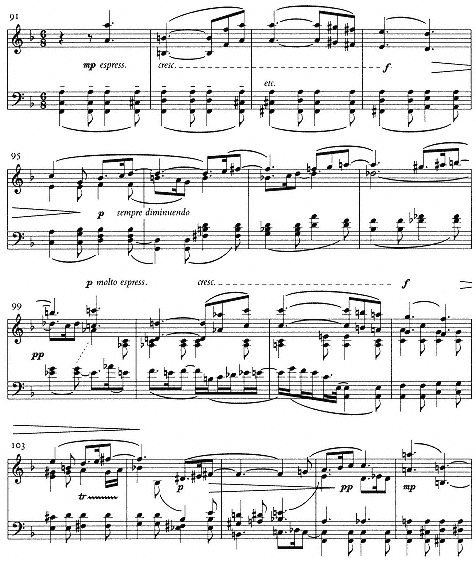
Example 8.19
Max Reger, String Quartet in D Minor, op. 74, I, second theme.
and Schoenberg display here, as in their youthful works, a profound affinity with these principles and an ability to transmute them into personal styles of great integrity.
After the D-Minor Quartet
The completion of the D-Minor Quartet was followed by a period of Lieder composition almost as intense as that of 1903-4. If the compositional energies of songs like Verlassen can be said to have been channeled into op. 7, those of the quartet itself seem to have flowed out into the group of songs from the fall of 1905, including Alles, op. 6, no. 2 (6 September 1905); Der Wanderer, op. 6, no. 8 (15 October); Am Wegrand, op. 6, no. 6 (18 October); Lockung, op. 6, no. 7 (26 October); and Mädchenlied, op. 6, no. 3 (28 October). Also drafted at this time was the fragmentary programmatic piano quintet, Ein Stelldichein, based on a Dehmel poem (published as Schoenberg 1980).[29]
Schoenberg claimed to have composed the Dehmel song Alles "very fast," while waiting for music paper with which to finish copying the D-Minor Quartet.[30] It is remarkable for its use of invertible counterpoint in the manner of op. 7 and for the extremely ambiguous tonal language, which settles into the tonic

Similar contrapuntal preoccupations are joined to a much more expressive language in Am Wegrand. The poem, by John Henry Mackay, which communicates alienation and despair in a manner not unlike Conradi's Verlassen, called forth an equally powerful response from Schoenberg. Am Wegrand shares the key of the quartet, D minor, and the wide-ranging, athletic opening melody of the voice seems cut from the same cloth as the main theme of op. 7. As in Verlassen, Alles, and the D-Minor Quartet, this melody forms part of a contapuntal complex that
[29] It has been claimed by Allen Forte (1978, 138) that "set consciousness"-that is, an intentional use of unordered pitch-class sets-begins for Schoenberg with the op. 6 songs composed in the fall of 1905. Forte bases his suggestion principally on what he analyzes as a frequent recurrence in the songs of Schoenberg's "musical signature," a six-note set made up of the pitch equivalents of letters from the composer's last name. Forte's analyses seem to me farfetched, in that to find the signature, he must often acknowledge complementation, transposition, and inversion of the set, atonal operations with which Schoenberg is not likely to have been acquainted at this time.
[30] See Newlin 1980, 63. Schoenberg does not mention Alles by name here, but it seems clear from the context of his remarks that he is referring to this song; there is no other song that corresponds in time to the final stages of the completion of the quartet in fall 1905.

Example 8.20
Am Wegrand , op. 6, no. 6.
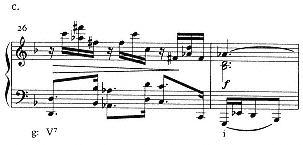
Example 8.20
continued
is subjected to inversion. From the three-note descending chromatic motive in the piano left hand (

Other similarities to the quartet are evident in Schoenberg's treatment of the main key. The opening bass motive, x, circumscribes the tonic D by semitone, a feature elaborated in the vocal version of the motive, x'. The upper half-step,



The introduction of the whole-tone complex in Am Wegrand is also related to procedures in op. 7.


Schoenberg's creative rhythm in the period 1903-6 seems to have dictated an alternation between Lieder and instrumental works. The achievements of the
songs of late 1905-the integration of whole-tone with diatonic-chromatic procedures in Am Wegrand; the contrapuntal intricacy of Alles; the "fluctuating" tonality, as Schoenberg called it, of Lockung, a song that "expresses an tonality without once in the course of the piece giving an triad in such a way that one could regard it as a pure tonic" (Schoenberg 1978, 383)-all these techniques were adumbrated to some degree in the D-Minor Quartet. They were to be carried over, in imaginative ways that Schoenberg himself could not have envisioned in 1905, into his next large-scale project, the First Chamber Symphony.
Chapter Nine—
The First Chamber Symphony, op. 9 (1906)
Judging from the disposition of materials in Sketchbooks II and III, Schoenberg began work on the First Chamber Symphony sometime between the end of 1905—after the spate of post-quartet song composition—and April 1906. The piece was completed by midsummer: the date at the end of the sketches and drafts for op. 9 in Sketchbook III is 17 July 1906; that at the end of the autograph score, 25 July. The First Chamber Symphony thus seems to have had a relatively swift and unproblematic genesis in comparison with the First Quartet, to which it is in many respects the direct heir.[1] The larger formal design of op. 7 is here condensed into a structure about half as long. The basic plan is shown in table 10. The streamlining results largely from the presence of a single development and from the drastic compression of the individual "movements." Unlike in op. 7, the finale introduces no new themes, but is purely recapitulatory.
Timings from two of the best recent recordings of the Chamber Symphony are included in table 10 to indicate not only how compact the work is in relation to op. 7, but also how well-balanced the various segments are from the viewpoint of duration.[2] The two outer movements, which are of approximately equal du-
[1] The publication history of op. 9, extending from 1912 to 1924, is slightly more complicated than its Entstehungsgeschichte. For full details, with a collation of the different printed sources, see SW B11/II: 14-28; see also Brinkmann 1977, 134-36.
[2] It should be noted that neither recording comes anywhere near the fast tempi suggested by Schoenberg's metronome markings for the first movement in 1922 edition of the Chamber Symphony. At the "sehr rasch" of m. 5, Schoenberg indicates that a half note should equal about 104. Reinbert de Leeuw, whose tempi seem very fast indeed here, takes the half note somewhere between 80 and 84. Although de Leeuw's tempi in the fast parts of the piece are noticeably quicker than Giuseppe Sinopoli's, his slow movement takes almost half a minute longer.
My own final tallies for timings in table 10 differ slightly from the totals given on the record liners; the difference can be accounted for by the fact that I have added the individual sections or movements individually, not always taking the same measure as the recording engineers of the silences or pauses in between.
| |||||||||||||||||||||||||||||||||||||||||||||
ration (4–5 minutes), are the lengthiest. As is suggested by the curved braces in the table, there is also greater balance, on either side of the central development and transition, between the first movement-transition-scherzo complex and the slow movement-transition-finale complex. (This balance is clearer in the timings of the recording by Sinopoli cited in table 10.)
Thematic and Formal Structure
The themes of op. 9 tend to be briefer, tauter, more compact than those of op. 7 (as has been observed by Brinkmann 1977, 138), but there are more of them. In the first movement, this profusion of material is accommodated within an ingenious design, which has not, to my knowledge, been previously clarified in print. Alban Berg (1921),[3] and most analysts following him (for example, Brink-
[3] Following the printed catalog of Berg's manuscripts prepared by Rosemary Hilmar (Grasberger and Stefan 1980, 99-100), I give the publication date of Berg's Thematische Analyse as 1921. The pamphlet itself bears no imprint date. It may in fact have appeared well before 1921, since Berg's contract for it, still in the archives of Universal Edition, bears the date 4 May 1918. (I am grateful to Sabine Franz of Universal for providing me with a copy of this document.) According to Willi Reich, the Analyse was completed and published in 1918 to coincide with a series of ten open rehearsals of the Chamber Symphony led by Schoenberg in June of that year (Reich 1965, 45). The one letter in the Berg-Schoenberg correspondence that mentions the analysis (Berg 1987, 268) gives no information about publication.
| ||||||||||||||||||||||||||||||||||||||||||||||||||||||
mann 1977, 144), have discerned a single exposition with a slow introductory portion (mm. 1-4), a large and multifarious first group (mm. 5-67), a transition (mm. 68-82), a lyrical second subject (mm. 82-113), and a fast closing group (mm. 113-32). But the first movement of op. 9 is best heard as comprising a double exposition, or pair of expositions (see table 11). We have seen in chapter 5 that such a design is proposed by Richard Swift for Verklärte Nacht (Swift 1977), but that this parsing is not supported by the thematic and harmonic disposition of the sextet. A much more persuasive case for this kind of plan can be made in op. 9. The principle of a double exposition is not, of course, without precedent. An obvious forebear is the classical-romantic first-movement concerto form. Richard Strauss's Don Juan, a piece Schoenberg surely knew well (it has the same tonic as op. 9, and its athletic thematic style may also have been influential) can also be heard as employing two expositions (a perspective discussed in Hepokoski 1992, 147). Although the conception of op. 9 may owe something to both models, Schoenberg's double exposition is sui generis; with it, he created a new formal synthesis of procedures with which he had been grappling imaginatively for over a decade.
The first exposition is preceded by two passages, which I shall call "cadences" because they serve to map out, or introduce emphatically, the two key areas, F
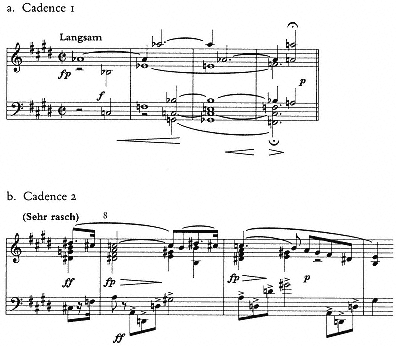
Example 9.1
First Chamber Symphony, op. 9.
and E, that are to dominate the succeeding expositions, especially the first (ex. 9.1).[4] Cadence 1 also behaves like a brief slow introduction. (I shall return below to the more specifically harmonic aspects of the expositions.) The two cadences also enclose the first statement of the horn "motto" of rising fourths that is to assume importance at larger formal articulation points in the piece. (In table 11 and in the discussion that follows, themes are distinguished by the exposition in which they originate; thus I/2 refers to theme 2 in exposition I. Since 1a is the same in both expositions, it will be referred to without a roman numeral.)
Each of the two expositions begins with the same theme (1a), which in both cases cadences on the tonic, E major. As has been suggested by Philip Friedheim (who, however, follows the tradition of perceiving a single exposition), this theme and subsequent ones tend to preserve the "thematic character" of the traditional sonata form, where "principal melodies remain strong and aggres-
[4] Berg 1921, 5, also refers to mm. 8-10 as the "cadencing theme," which, he suggests, appears throughout the piece when there is a strong cadence in E major.
sive, secondary melodies expansive and lyric" (Friedheim 1963, 337). Theme 1a is indeed aggressive; it is also somewhat asymmetrical and open-ended. It is succeeded by theme I/1b, which definitely has the character of a modulatory transition, especially by virtue of its prominent use of sequence (in overlapping four-measure units).
In both expositions, the "second" themes provide genuine contrast-in mood, in key, and in thematic material. The first of these (I/2, m. 32) differs from what has come before in extending a full (and regular) eight measures and in being accorded an actual counterstatement or repetition (beginning at m. 39), which, however, soon begins to deviate from the original. Similarly, the A-major theme (II/2) is an expansive one, lasting nine measures (clearly heard as an extension of eight by the varied repetition of m. 88 as m. 89). After a transitional addition of five measures, this theme too has a counterstatement, beginning (in the horn) at m. 97. Like the counterstatement of I/2, this one soon deviates from the original model.
After the cadences at the close of exposition II, cadence 2 and theme 1a make yet another return (mm. 133-36)-one that might suggest either another exposition or the beginning of a development section. In fact, however, the primary thematic material takes a different direction at m. 142 and leads toward the introduction of scherzo material at m. 148.
From the formal/thematic viewpoint, the scherzo of op. 9 is no less remarkable than the first movement. Schoenberg here moves away from the clear scherzo-trio-scherzo plan of op. 7, but retains the essential thematic dualism of that design. The two principal themes are closely related. The nervous accompanimental figure to theme 1 (ex. 9.2b) is modified to become theme 2 (ex. 9.2c). The principal voice of theme 1 can also be heard to derive from the prominent ascending semitones in the second violin at cadence 1 (ex. 9.2a).
The way in which the two themes are introduced and developed gives the scherzo a shape closer to sonata form than to the tripartite scherzo plan:
Theme 1 [scherzo], m. 160
transition, m. 184
Theme 2 [trio], m. 200
Development, m. 215
Recapitulation [scherzo], m. 249
The passage in mm. 215-18, with the final appearance (for the moment) of theme 2, followed by the sustained horn pedal, clearly indicates the end of an important
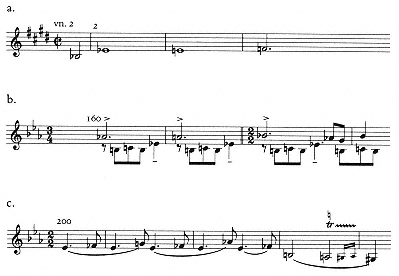
Example 9.2
First Chamber Symphony, op. 9, derivation of scherzo themes.
segment. It is followed by the reappearance of a portion of theme 1, precisely in the way we might expect at the beginning of a development section. The "recapitulation" is remarkable for its extreme compression, which in a sense fulfills the latent identity between themes 1 and 2: they are now recapitulated simultaneously in mm. 253-58
The reader will recall that in op. 7 the reprise of the scherzo leads directly into a large development section, in which scherzo material gradually gives way to that from the first movement. Schoenberg's strategy in op. 9 is somewhat different. The end of the scherzo is clearly demarcated by the sustained fortissimo Es of mm. 274-79, and by the reappearance of the horn motto, now descending in fourths (mm. 279-80). The development section begins with a distinct contrast of key, tempo, and thematic material. The initial motive of theme I/2 reappears in its original key, F minor. It is followed-interrupted, one might almost say- by cadence 1, then by theme II/2, which dominates the first part of the development.
Berg rightly observes that the development section of the Chamber Symphony divides into three segments: part I, mm. 280-312; part II, mm. 312-35; and part III, mm. 335-67 (Berg 1921, 9-11). The segments are distinguished primarily by means of thematic material, which is arranged in order of progressively greater
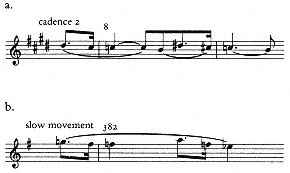
Example 9.3
First Chamber Symphony, op. 9, derivation of slow movement theme.
rhythmic activity, so that a listener might perceive an increase in tempo, although there is none. Throughout this process, Schoenberg preserves the essential character of the themes as they were introduced in the expositions and the scherzo. Thus part I of the development begins with the slower "second" themes from the first movement expositions and is dominated especially by II/2, whose lyricism makes an appropriate contrast with the headlong pace of the scherzo. At the beginning of part II, the tempo quickens to the Anfangszeitmaß, the "sehr rasch" of the opening of the piece. It remains essentially at this tempo for the rest of the development; the impression of increasing speed is created by Schoenberg's choice of themes.
Part II is governed by theme II/1b, which in its original appearance (m. 68) preceded II/2 and formed a kind of transition from the assertive II/1a. Here it has the opposite function, representing an increase in rhythmic activity from II/2. Part III begins with part of theme 1 of the scherzo, which represents a still greater increase of rhythmic activity. The scherzo theme is combined with II/1b; gradually the other "fast" theme, 1a, emerges (beginning at m. 341).
The development culminates with the triple forte chords in fourths of mm. 363-68. This sonority represents a compression into a simultaneity of the horn motto powerfully presented in mm. 358-62. (I return to the significance of this moment below.) This passage at 363-68, standing essentially at the midpoint of the work, is the formal analogue of the massive liquidation of the first theme before K in the D-Minor Quartet. In the quartet, the liquidation was followed directly by the slow movement; in the Chamber Symphony, this moment is followed by a kind of regeneration of the motto and of cadence 1 in mm. 368-77.
The main theme of the slow movement derives audibly from the twofold dot-
ted figure of cadence 2 (ex. 9.3a, b). The relationship is especially appropriate here since the theme comes after the horn motto and cadence 1 and thus occupies a formal position analogous to that originally occupied by cadence 2 (in mm. 8-10). By making this analogy to the opening of the piece, Schoenberg signals the beginning of a large new segment of the Chamber Symphony.
The slow movement proper has a lucid design, in which material of great variety is fitted into a compact structure:
Introduction/cadence (mm. 378–81)
Main theme (mm. 382–85)
Contrasting theme (mm. 385–90)
Main theme repeated and varied (mm. 391–94)
Contrasting theme repeated and varied (mm. 395–97)
Introduction/cadence repeated and extended (mm. 398–404)
Main theme (mm. 405–7)
Coda (mm. 407–10)
One distinctive aspect of this design is the reappearance of the introduction/cadence at m. 398 to form the real climax of the section.
The slow movement is followed by the return of the fourths motto and by cadence 1; this leads into a lengthy passage, mm. 415–34, that in the overall analysis of op. 9 (table 10) has been called episode/transition. This segment seems to have two functions. First, it is a continuation and thematic variation of the slow movement. The last segment of the theme of this section, consisting of two descending semitones and rising major third (diminished fourth), is derived clearly from the slow movement theme, a derivation made more obvious in the horn melody that emerges at m. 430 (ex. 9.4a, b). Second, the segment of mm. 415–34, which has a B-major key signature, appears intended to function as a transition to the recapitulation, which may be said actually to begin with the E-major key signature at m. 435. Despite its apparent functions, however, the passage from mm. 415–34 is one of the most puzzling in the Chamber Symphony, as will be discussed below in conjunction with the recapitulation.
The recapitulation/finale of the Chamber Symphony posed the kind of challenge Schoenberg had faced several times before in his large-scale instrumental compositions. In op. 9 the solution proves as ingenious as the exposition. Schoenberg creates a double recapitulation that is analogous but in no way identical to the double exposition in terms of harmonic areas and thematic disposition (see table 12). The thematic components of the two expositions are now intermingled
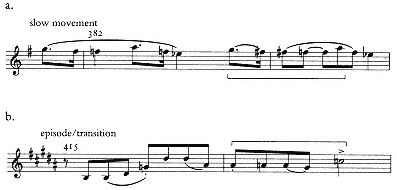
Example 9.4
First Chamber Symphony, op. 9, relation of slow movement theme to episode/transition.
in a logical yet flexible way. The double recapitulation is followed by a two-part coda.
The analysis suggested in table 12 differs not only in detail but overall from that of Berg, who places the start of the recapitulation at m. 410, with the horn call, and the "coda" at m. 497, at the beginning of what I have called recapitulation II. Berg calls my coda II an Endkoda. Berg's coda seems unusually and disproportionately long and does not take sufficient account of the treatment of the slow movement theme, which is actually taken up at greater length than its original presentation. In the slow movement proper, the theme unfolds for only twenty-seven measures before giving way (at m. 410) to a new transitional theme in B major. The fuller treatment of the theme at mm. 508–41 would seem more appropriately considered part of a recapitulation than a coda. Placing the beginning of the coda at m. 555, as I have suggested, creates an analogy with the codetta in exposition II: in both, a transformed, fast version of II/2 leads into cadence 3 (ex. 9. 5a, b).
Wherever one chooses to place the traditional formal boundaries, it is important to remember that these are only labels of convenience that fix—and thus to some extent falsify—what is in the Chamber Symphony an extremely fluid process. This fluidity makes it particularly difficult to pinpoint the actual beginning of the recapitulation. Schoenberg's principal compositional goal is to prepare the return of the tonic, E major. The portion of the slow movement that comes after the horn motto and fourth chords of mm. 410-14 is given a B-major key signature. The tonic key signature returns at m. 435, with the appearance of theme II/1b, which, however, really continues in the previous B major. The tonic itself begins
| |||||||||||||||||||||||||||||||||||||||||||||||||||||||||||||||||||||
to emerge only at m. 448 with theme II/2, then more definitively with the simultaneous presentation of 1a and cadence 2 at m. 476. Following convention, I give the moment at which the key signature changes as the beginning of the recapitulation, but one might with equal justification point to the fortissimo statement of the horn motto at m. 473.
Dominant Relationships
The matter of recapitulation-and, indeed, of formal structure in general-is intimately bound up with the harmonic dimension of op. 9, especially with the structural role of the dominant. The principal rationale for arguing for a double

Example 9.5
First Chamber Symphony, op. 9, relation between codetta (a) and final coda (b).
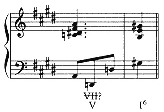
Example 9.6
Schoenberg's analysis in Structural Functions of Harmony of cadence 2 in First Chamber Symphony, op. 9.
recapitulation is that as in the exposition there is a double approach to the tonic: first at m. 448, then again more explicitly at m. 497. This procedure is roughly, but surely intentionally, parallel to the double approaches at mm. 8-10 (with cadence 2) and mm. 56-58. What is significantly different from the exposition is the role played by the dominant, B major, in these later passages and in coda II at mm. 573-76.
In the expositions, Schoenberg tends to avoid any sustained or explicit dominant of E major. Thus in cadence 2, as the composer himself demonstrated in Structural Functions, there is no B in the bass of the dominant chord; it must be inferred through "multiple root reference of a diminished 7th chord" (Schoenberg 1969, 110-11; see my ex. 9.6). (In fact, a B root is heard fleetingly in the horns on the last beat of m. 8.) But at the recapitulation, as in the recapitulatory portions of opp. 4, 5, and 7, Schoenberg clearly felt the need for a stronger V-I

Example 9.7
First Chamber Symphony, op. 9, cadences to E from the dominant.
resolution. The most forceful such cadences, with a clear B in the bass, come at mm. 493-97 and at 572-76 (ex. 9.7a and b).
During the compositional process of the Chamber Symphony, as in that of Verklärte Nacht and the First Quartet, Schoenberg was clearly concerned with, and somewhat uncertain about, how much dominant preparation would be necessary or appropriate toward the end of the work. The one major compositional change indicated-but then revoked-in the autograph score of op. 9 was made, I believe, precisely because of this concern. In the autograph (at the Pierpont Morgan Library), all of mm. 415-34, the passage with the B-major key signature that has been referred to above as an episode/transition, is indicated for deletion with a red pencil; Schoenberg used a "VI-DE" to cut directly from m. 414 to the present m. 435-that is, from just after the horn motto and cadence 1 to the recapitulation of theme II/1b in B major. Then he changed his mind and wrote
"bleibt" above the passage, thus restoring it in full. It is not clear exactly when he would have made these markings, but it was certainly after the autograph was written out.[5]
Schoenberg's vacillation about the episode/transition is suggestive. As a listener to the Chamber Symphony and student of the score-well before I had ever consulted the autograph-I had found the passage at mm. 415–34 oddly stagnant for so relentlessly logical a composition. Are we to take it as a resumption of the slow movement after the interpolation of the horn motto and cadence 1? As such, it would break the precedent of using the motto as a marker of important formal junctions in the large-scale form. Or is it a transitional episode meant to lead into the recapitulation? In this latter role, it seems unusually, uncomfortably long for this work, where transitions tend to be relatively brief and focused.
That Schoenberg considered cutting mm. 415–34 can be taken as an indication that he too was somewhat puzzled about the function of the episode/transition. As he realized, the horn motto and cadence of mm. 411–14 could lead quite smoothly and logically, as indicated by the provisional cut, to the reprise of theme II/1b in m. 435. And Schoenberg may have felt that since the slow movement theme already receives such an extensive recapitulation—expansion, really—at mm. 508-41, an extensive episode derived from the slow movement theme at mm. 414-34 would come to seem redundant.
In the end, however, Schoenberg's instincts told him to leave the passage intact. He did so, I believe, not because of its contribution to the development of the slow movement theme, but because of its harmonic implications: these measures provide necessary time spent in or about the dominant. The appearance of II/1b in the dominant at m. 435 (it is heard in B despite the change of key signature to E) would not alone be sufficient; the passage at mm. 414–35 gives additional weight to the dominant. Even so, very little of the episode/transition actually sustains a dominant of E, since harmonic stability is constantly threatened by the pervasive chromatic counterpoint. One suspects that the key signature of B retains an almost purely symbolic value for Schoenberg. Somewhat like the A major of the rondo theme of op. 7 examined in chapter 8, it represents the dominant that Schoenberg was finding increasingly harder to sustain as a functional element in his music.
Whole-Tone and Quartal Elements
The role of dominants in op. 9 is intimately bound up with Schoenberg's extensive use of whole-tone and quartal elements. At the opening of the work,
[5] Similar cuts are indicated in the autograph score of Schoenberg's own four-hand arrangement of op. 9 (at the Schoenberg Institute). For a description of both cuts, see SW B11/II: 13; and B5: 85.

Example 9.8
First Chamber Symphony, op. 9, whole-tone chord as dominant seventh of F.
Schoenberg explicitly-almost didactically-demonstrates how whole tones and fourths can (and will) penetrate both the vertical and horizontal dimensions of the music. First, with cadence 1, comes an essentially chordal or vertical presentation, a fourths-whole-tone-triad progression resolving to F major. The horn motto then horizontalizes the fourths, and the transition to cadence 2 does the same for whole tones by successively unfolding the augmented triads


I have already reviewed Schoenberg's own theoretical derivations of the whole-tone complex and demonstrated something of its realization in op. 7 (chapter 8). We recall that in both theory and practice Schoenberg treats whole-tone scales or chords not as purely symmetrical, rootless phenomena, but as harmonically functional ones; he often derives whole-tone structures from, or relates them to, conventional dominants. In this respect, as in so many others, the First Chamber Symphony is a worthy successor to the First Quartet, making good on the inheritance. The second chordal component of cadence 1 contains five notes of the whole-tone scale (ex. 9.8). If inverted so as to put the C in the bass, the chord can be heard to function as a dominant of F major, with the fifth simultaneously raised and lowered, in the way suggested by Schoenberg in Theory of Harmony (1978, 392) and discussed above in connection with the D-Minor Quartet. (See the similar analyses of the opening of op. 9 in Morgan 1991, 66, Rexroth 1971, 356-59, and Brinkmann 1969, 6-8.) The dominant function might be said to be reinforced by the doubling of the leading tone,

This aspect of the whole-tone complex becomes still more explicit at the cadence to theme I/2 in F minor at mm. 30–32 (ex. 9.9). In m. 30, all six notes of the whole-tone scale are present; although not sounded as a chord, they are clearly oriented around or toward the C root. In the next measure, the C fully

Example 9.9
First Chamber Symphony, op. 9, cadence to theme I/2.
establishes itself as a dominant, and the whole-tone scale gives way to a more conventional half-step approach to F in the violins.
Schoenberg's theoretical and compositional treatment of chords built of fourths is similar to his approach to the whole-tone complex. In Theory of Harmony, he observes that fourth (quartal) chords "are chords like all others" (1978, 404) and can be produced by-and thus can function as-alterations within the triadic system (see also Rexroth 1971, 318–25). He also stresses their possible dominant function: both four-part and five-part quartal harmonies "can be substitutes for a dominant, from which they are derived by lowering the root (if one wishes to admit such), the seventh, and the fifth for the four-part quartal chord" (Schoenberg 1978, 405). It is striking that Schoenberg should suggest-even if diffidently and parenthetically-the lowering of the root, the one chord component that he elsewhere claims not to be subject to alteration: "The roots are, in our conception, fixed points from which relationships are measured. The unity of all the measurements we have found is guaranteed by the immobility of these points. But then one may not move them!!" (Schoenberg 1978, 234). Schoenberg's willingness to condone the possibility of root alteration in quartal harmonies shows how strong is his impulse to relate even the most exotic constructions to diatonic roots.
The resolutions of the quartal harmonies demonstrated in Theory of Harmony are especially relevant to an understanding of compositional practice in the Chamber Symphony. Schoenberg observes that in a six-part quartal chord, the top voice forms a minor ninth with the bass. Because this ninth represents "the first 'rather sharp' dissonance among the fourth chords," he suggests that the resolution of the ninth be a priority (Schoenberg 1978, 405–6). One of his solutions in Theory of Harmony, as reproduced in ex. 9. 10a, is quite close to cadence 1 in op. 9 10b, which is a reduction of ex. 9. 1a). Both begin with a six-
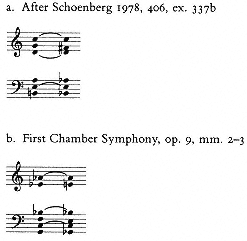
Example 9.10
Resolution of six-part fourth chord.
part quartal chord; in both, three notes, including the ninth above the bass, are held over into the next chord, which is in both cases a whole-tone sonority.
In the Theory of Harmony example, Schoenberg claims to demonstrate "a connection that also appears in my Kammersymphonie " (406). In fact, however, the six-note quartal harmony in mm. 2-3 of op. 9 does not resolve precisely as indicated in Schoenberg's textbook example, because as can be seen in ex. 9. 10b, the whole-tone chord of resolution in cadence 1 has five, not six, pitch classes. Instead of moving down by half-step, as in the model (ex. 9. 10a), the second voice from the top resolves up, from




In all, cadence 1 appears five different times in the Chamber Symphony: once at the opening, twice in succession just before the slow movement at mm. 374–77, and twice again at the end of the slow movement, mm. 411–14. In none of these places does the pattern correspond to Schoenberg's model in Theory of Harmony. In the passages at mm. 374–77 and 411–15, the cadence first behaves as at the opening, leading to F major (ex. 9.11a and d), and is then refashioned to lead toward the key of the succeeding passage. The reworking at mm. 376–77 (ex. 911b) corresponds to a different model proposed in Theory of Harmony (ex. 9.11c; Schoenberg 1978, ex. 336, m. 3), where the six-part quartal chord leads to
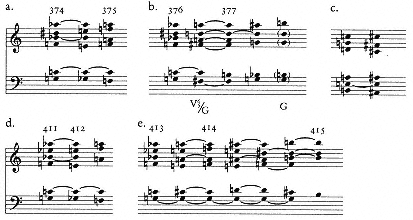
Example 9.11
First Chamber Symphony, op. 9, appearances of cadence 1 (a, b, d, e); resolution of six-part fourth chord after Schoenberg 1978, 406, ex. 337, m. 3 (c).
a first-inversion dominant seventh. In op. 9, the dominant seventh is V of G, the key of the slow movement. It could be said that this passage makes explicit or overt the dominant function that was implied in the original form of cadence 1, which has just been heard once again before the reworking. At the final occurrences of cadence 1, in mm. 411–15, Schoenberg repeats the original form once again (ex. 9.11d), then modifies it still further to resolve eventually to the dominant of E major (minus the fifth; ex. 9.11e).
Neapolitan Relationships
In Theory of Harmony, Schoenberg notes that quartal sonorities "place their stamp on everything that happens" in the Chamber Symphony (Schoenberg 1978, 404). While it is true that both cadence 1 and the horn motto blaze a trail through the work, they constitute only one aspect of its richly complex tonal world. Indeed, one harmonic relationship that seems to lie at the core of much of op. 9 derives directly from neither whole tones nor fourths (although an affinity to the latter will be suggested): it is generated by the half-step E-F. The Chamber Symphony, especially its first movement and finale, constitutes Schoenberg's most profound exploration to date of the relationship between a tonic and its Neapolitan upper neighbor.
The key areas of F major and E major are emphatically juxtaposed at the very opening, where cadence 1 is in the former, cadence 2 in the latter (see above, ex. 9.1). This juxtaposition, so portentous for the work as whole, was apparently not
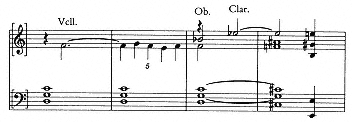
Example 9.12
First Chamber Symphony, op. 9, sketch for cadence 1, in Sketchbook II, p. 92.
part of Schoenberg's earliest notated conception. In the first surviving sketch for cadence 1 (ex. 9.12; see also SW B11/II: 42 [S3]) the opening chord is built from a different set of fourths,

Cadence 2 is more conventional than cadence 1 and is accompanied by (or accompanies) a dynamic melodic gesture. This can be taken as a sign that E major, and not the F major of the introduction, is the real tonal center of the work. Another sign is the prominent motivic gesture within cadence 2,



The cello theme, 1a, also embodies within itself the crucial F-E harmonicthematic relationship. In m. 12, the theme swerves sharply from its E-major orbit with the ascending figure,


It is instructive to consider the pervasiveness and the boldness with which Schoenberg exploits the Neapolitan in op. 9 (and there is more to say about this below) in light of his own theoretical statements. Like other nineteenth-century
theorists, Schoenberg sees the tonic and its Neapolitan as related through the mediation of the subdominant minor (A minor in the case of op. 9), in which region the Neapolitan triad forms a diatonic chord (VI, F major). But Schoenberg also decides that "in spite of the mediation of the minor subdominant relation: these two chords [a tonic and its Neapolitan] are about as remotely related as chords can be. And if we connect them so directly we are right on that boundary where we can say: all chords can be connected with one another" (Schoenberg 1978, 235). Even in Schoenberg's more systematic treatment of harmonic relationships in Structural Functions of Harmony, the Neapolitan is still a remote, slippery phenomenon; in the schematic chart of the regions, in which keys are visually arranged around a central axis according to nearness or remoteness to the tonic, the Np hovers ambiguously outside the main grid (Schoenberg 1969, 20).
Despite the remoteness of the Neapolitan in theory, this scale degree is explored in practice in Schoenberg's earlier tonal works with great imagination. We have already examined some of these procedures in Verklärte Nacht (chapter 5) and Gurrelieder (chapter 6). More direct precedents for op. 9 are to be found in three works in which this tonal relationship occurs at the same pitch level, that is, E-F. Two of these are the songs Traumleben, op. 6, no. 1, and Natur, op. 8, no. 1, which were drafted on the same day, 18 December 1903. (Natur was completed and orchestrated in March 1904.) In both songs, the tonic E major is frequently enriched by, and inflected toward, the Neapolitan F. In Traumleben, the opening melodic phrase contains all the notes of the F-major triad, spelled enharmonically as A,


A still more direct way of shuttling between the key areas of F and E—and one highly relevant to Schoenberg's method in op. 9—appears in the slow movement of the D-Minor Quartet, op. 7. Although this movement, which has an ABA' form, begins in A minor, the principal key area of the A section is F minor/major. Toward the end of this section (one measure before K 45 in ex. 9.13), Schoenberg confirms F major with its own dominant. At the cadence in K 45, Schoenberg introduces in the second violin (imitated in the cello) a phrase from the second group of the first movement. In its final statement, in the viola in
[7] For further discussion of Traumleben and these particular Neapolitan relationships, see Cone 1974, 30–32; Wintle 1980, 57–64; and Lewis 1987, 32–37.

Example 9.13
First String Quartet in D Minor, op. 7, slow movement.
K 47-48, this phrase emphasizes the neighbor-note motives


On the final beat of K 48 (just before the double bar and change of meter), the lower voices sustain the dyad








In an abstract theoretical sense, the relationship between E major and F minor, between a tonic and its Neapolitan minor, is still more remote than the conventional one, since it involves a further transformation or substitution, that of F minor for F major. This particular relationship is so remote that Schoenberg addresses it specifically nowhere in either Theory of Harmony or Structural Functions.[8] And yet in the tonal world of the First Chamber Symphony, F minor is really closer to the tonic than is F major. The key area of theme I/2 represents an attempt to reconcile or bring together the two key areas, F and E, which have been juxtaposed in the first theme group. The F-minor triad shares one note,


Schoenberg himself may well have been thinking along these lines when composing op. 9. Such at least is one possible interpretation of some of the fascinating sketches for the F-minor theme, I/2. The position of these sketches within

Example 9.14
Connection of E major to F minor through stepwise voice-leading.
the sketchbook suggests that this theme may originally have been intended as the main theme (a hypothesis advanced by Schmidt in SW B11/II: 43). These sketches directly follow those for the opening cadence 1 and precede those for the theme that eventually became 1a. Schoenberg himself transcribes five of the twelve sketches for the F-minor theme in his essay "Heart and Brain in Music" (Schoenberg 1975, 59-60).[9] He makes no comment on the harmonic, or enharmonic, implications of the theme's evolution; his goal is only to give an idea of how much labor and revision was involved in forging the theme. But nothing speaks more tellingly of the relationship Schoenberg attempts to establish between E and F than the successive drafts of I/2, in which the theme, always at the same pitch level, is first cast in the key of E major, then gradually shifted toward F minor.
It is not necessary here to trace the entire evolution of the theme across the surviving sketches (the reader can consult the transcriptions and commentary in SW B11/II: 45-49 [S8-9, 11-20, 33, 39, 40]); but some idea of this process can be given. In the first surviving sketch (S8, excerpted in my ex. 9.15a), the theme appears underneath a sustained dyad





The new harmonic context of F minor is made explicit in S16 (ex. 9.15c), where, in the upper staff, Schoenberg moves by semitone voice-leading from E major to F minor (and then beyond, to A major) in exactly the fashion suggested above in my ex. 9.14: the fifth of the E triad is raised to C, which is then interpreted as a dominant of F minor, so that the E resolves up by half-step to F. The sequence by which F minor is reached is now repeated, so that we end up at

[9] Schoenberg's examples correspond to those transcribed in SW B11/II: 46-48, as follows: Schoenberg's ex. E=S11 ex. F=S12; ex. G=S13; ex. H=S16; ex. I=S17.

Example 9.15
First Chamber Symphony, op. 9, sketches for theme I/2, in Sketchbook II, pp. 92–94, 102.

Example 9.16
First Chamber Symphony, op. 9, Schoenberg's derivation of theme I/2 from 1a (from Schoenberg 1975, 85).
triad or of the following augmented triad; the progression now begins in F minor. The earlier sketches thus spell out explicitly (almost as if in a theory book) the voice-leading relationship between E major and F minor, a relationship that can only be inferred in the final version.
In one of his best-known musical analyses, presented in two different essays, "My Evolution" and "Composition with Twelve Tones," Schoenberg showed how his "subconscious" (as dictated by the "Supreme Commander") had created a deep structural relationship between the two apparently contrasting principal themes (my 1a and I/2) in the first group of the Chamber Symphony (Schoenberg 1975, 85, 222-23). He isolates certain pitches of 1a and demonstrates how by inversion they form the notes of I/2 (ex. 9.16). The derivation may seem a little farfetched, calling to mind the more fanciful thematic analyses of Rudolf Réti (Réti 1951), but from the viewpoint of the E-F relationship investigated here, Schoenberg's analysis is suggestive indeed; it establishes an identity between the


To continue with the Neapolitan story of the Chamber Symphony: the relationships between E and F set out in exposition I come into play again at the end

Example 9.17
First Chamber Symphony, op. 9, climax of F–E juxtaposition.
of the development section, at mm. 355-68, where the two pitches are forcefully juxtaposed in one of the most compelling passages of the work (ex. 9.17). Here the fourths motto reappears, triple forte, in a form that at first descends and ascends between the outer extremes of




This remarkable passage, which Adorno (citing an anonymous conductor) aptly characterizes as resembling a "glacier landscape" (Adorno 1981, 158), lies virtually at the midpoint of the Chamber Symphony and can be said to represent its most powerful and dissonant climax. Here the F and E have been brought together in (or around) a six-note quartal harmony of the type that, as discussed above, Schoenberg characterized as "rather sharp," with the minor ninth between the outer parts. It is here, at the climax, that we are made aware of the relationship between fourths and Neapolitan half-steps, phenomena that have up to this point been manipulated more or less separately. Both are embodied in the chord of m. 364, with F at the top and E at the bottom.
The F-E relationship is fully resolved only near the very end of the Chamber Symphony, at mm. 582-84 (ex. 9.18). Here a sustained F-major triad moves, via an intervening whole-tone run, to E major for the last time. This cadence follows, and is meant to be heard in apposition to, the more conventional dominant cadence of mm. 573-76 (see above, ex. 9.7b). Indeed, it seems to replace or su-
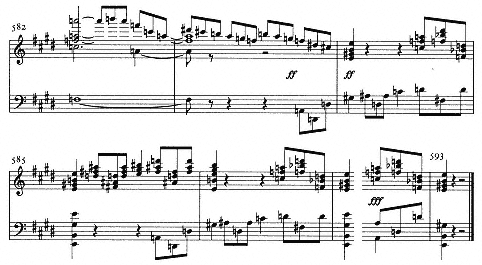
Example 9.18
First Chamber Symphony, op. 9, resolution of F–E relationship.
persede that earlier cadence, as if Schoenberg is saying that in the Chamber Symphony, Neapolitan relationships have greater force than dominant ones. In these final pages, which seem to tie together all the harmonic and thematic threads of the work, the F-E nexus is further enriched by the strong presence of C major, which is both the dominant of F and Neapolitan to B. It is in the latter role that C functions principally here, although at first it moves directly to E major without any intermediate resolution to the dominant.
At m. 562, cadence 3 appears for the first time since the first movement. It is reiterated forcefully over the next nine measures. The first two times it resolves to C (ex. 9.19a); then it moves twice to E major (ex. 9.19b). On the downbeat of m. 567 the cadence resolves again to C; this resolution is now prolonged or expanded over four measures as the bass descends through the complete wholetone scale from C to C. In mm. 572-73, the C at last resolves downward to



Example 9.19
First Chamber Symphony, op. 9, final appearances of cadence 3.
in the bass derives not from a traditional A major but from the Neapolitan realm of F (and its related keys, C and

More than any other instrumental work of Schoenberg's early period, the Chamber Symphony is characterized virtually throughout by an urgent, occasionally frantic, quality. One has the feeling that (to adopt an Adornian mode of expression) the musical material itself is pressing up against its own technical and expressive limits. With its fifteen individual voices competing for attention, the Chamber Symphony represents, as Reinhold Brinkmann has suggested, an extreme of polyphonic subjectivity (Brinkmann 1977, 148). Schoenberg's suggested metronome markings (virtually impossible to execute) make the faster themes of op. 9 seem especially breathless. The themes of op. 9 also generally have an expansive range, both tonally and registrally. Cadences or cadential figures are often repeated, as if insisting on closure in the face of skeptical disbelief. Indeed, as I have suggested, the piece begins with two cadences that take on important structural and thematic functions. In this way Schoenberg seems to be
exploring the possibility, or the adequacy, of closure in a complex, tonally advanced composition.
Schoenberg considered op. 9 to represent the "climax" of his "first" (or tonal) period:
Here is established a very intimate reciprocation between melody and harmony, in that both connect remote relations of the tonality into a perfect unity, draw logical consequences from the problems they attempt to solve, and simultaneously make great progress in the direction of the emancipation of the dissonance. This progress is brought about here by the postponement of the resolution of "passing" dissonances to a remote point where, finally, the preceding harshness becomes justified.
SCHOENBERG 1975, 84
Our investigation of the E-F relationship in the sketches and the finished work has, I hope, revealed a profound example precisely of Schoenberg's ability to bring "remote relations" into a "perfect unity" in a logical fashion. We have not looked closely here at the opposite tendency mentioned by Schoenberg, at the incipient emancipation of dissonance. The emphasis has been primarily on forces of resolution and coherence, for I believe that the First Chamber Symphony is ultimately a work that confirms or affirms the power of tonality to articulate large-scale form. Within the frantic voice of op. 9, there is also a tone of joy, a sense of exuberance ("stormy jubilation," as Schoenberg described the horn motto in his Theory of Harmony [1978, 403]). The First Chamber Symphony is the last big composition of Schoenberg's early period to embody this attitude. As we shall see in the next chapter, the Second Chamber Symphony and Second Quartet take a more somber, sober approach to the problems of tonal composition.
Chapter Ten—
The Second Chamber Symphony, op. 38, and the Second String Quartet, op. 10 (1906–1908)
After completing the First Chamber Symphony in July 1906, Schoenberg immediately set to work on another one; the first sketches for the Second Chamber Symphony were made in August. Yet he was to complete neither this nor any other large-scale work for two years. From the winter of 1906-7 on, Schoenberg's writing of op. 38 (I shall refer to the Second Chamber Symphony by the opus number it eventually bore) was essentially overtaken by the composition of other works, including the songs opp. 12 and 14; the chorus Friede auf Erden, op. 13; the Second Quartet, op. 10, begun on 9 March 1907; and some of the songs of the Hanging Gardens cycle, begun in March 1908. (In Sketchbook III, which contains material for most of these works, there are also sketches from this period for songs based on the poetry of Dehmel, Goethe, Gottfried Keller, C. F. Meyer, and Hermann Löns, as well as for an opera based on Gerhard Hauptmann's Und Pippa tanzt.) Schoenberg returned intermittently to the Second Chamber Symphony, most notably during 1911 and 1916, but was not to complete the work until 1939.
It is not possible to give consideration here to all the significant works composed-let alone those sketched-during the extraordinarily creative two-year period between mid 1906 and mid 1908. This was a critical time in Schoenberg's early career, during which he began to make the break with triadic, functional tonality as an organizing principle, completed with the Piano Pieces, op. 11, of 1909. A detailed investigation of the technical means by which Schoenberg's music evolved into atonality (a word he himself disliked) is beyond the scope of this study.[1] Here I shall attempt to convey something of this development through an
[1] Although there are studies of individual pieces from the period 1906-9 (a notable one is Brinkmann 1969, on op. 11), there has been no study of this period as a whole in Schoenberg's output. Two articles that deal, in very different ways, with the transition to atonality across a broad range of works are Cone 1974 and Forte 1978.
analysis of the two instrumental works that span this period, the Second Chamber Symphony and the Second String Quartet (the latter also, of course, a vocal work). The first movement of op. 38 can be seen as perhaps Schoenberg's last fully tonal masterpiece of the early period. The quartet begins to call into question the kind of procedures handled with such assurance in op. 38; indeed, the quartet is, in a sense, "about" the conflict or differences between tonal and atonal procedures.
An essential kinship between these two pieces has gone largely unnoticed in the Schoenberg literature, perhaps because the Chamber Symphony was completed only in 1939 and is thus taken to be one of Schoenberg's later works. But as Sketchbook III reveals, the two pieces were to a large extent composed in tandem during 1907-8 (see table 13). By the fall of 1907, simultaneously with the completion of the first movement of op. 10, Schoenberg had completed in the sketch-book a continuous draft, in short score, of almost all of the first movement of the Second Chamber Symphony (through m. 143) and 85 full measures of the second. He also began to copy a full score, which was then broken off in August 1908, shortly after the completion of op. 10. As far as it extends, this full-score fragment, printed in SW B11/1: 147-97, is in all important respects identical to the final version published as op. 38, apart from some aspects of instrumentation and orchestration. Thus we can legitimately assess the first movement up to the coda (m. 143) as a work of 1906-8.
It is not only the chronological proximity and the intertwined sketching that suggest that opp. 10 and 38 be considered together. They are also both Gegenstücke to their immediate predecessors in their respective genres: that is, the Second Chamber Symphony is to the First somewhat as the Second Quartet is to the First Quartet. This relationship is most obvious in the larger formal design. Both the Second Chamber Symphony and Second Quartet appear to have been conceived at the outset as (or, at any rate, soon evolved into) works in separate movements. In this sense they both depart from the larger four-in-one-movement design of opp. 7 and 9. The similarity extends further into the very stuff of musical style and compositional technique. Both op. 10 and op. 38 tend to move away from the dense, almost self-consciously dissonant and gritty contrapuntal style so characteristic of opp. 7 and 9. This is not to say that there is any shortage of counterpoint, but the overall impression, especially in the first movements, is of a more lyrical idiom and a less cluttered texture.
The sketches bear out this assertion to a large extent, especially if one compares the first notated thoughts for the respective opening themes of opp. 7 and 10. The sketch for op. 7 (SW B20: 36) shows initially only the bass and theme (some inner parts are filled in at mm. 6 and 9); it is essentially a two-part contrapuntal framework. The first sketch for op. 10 (SW B20: 174) is more clearly homophonic: a melody line supported by harmony (with some contrapuntal move-
| ||||||||||||||||||||||||||||||||||||||||||||||||||||||||||||||||||||||||||||||
ment indicated in the implied second violin line). (A similar harmonic conception dominates the sketches for the themes from mm. 16 and 43; see S4 and S5 .)
The effect of this more homophonic texture in both op. 10 and op. 38 is to place more emphasis—at least in the opening themes—on fluent motivic development in the primary voice. Both themes unfold by a process in which a very brief initial motivic gesture is presented, then immediately modified. In op. 38 (Appendix ex. R), the motive becomes displaced rhythmically by an eighth beat and takes on an additional eighth note; the melodic pattern is modified to move upward past the initial



The Second Chamber Symphony, op. 38
Christian M. Schmidt has suggested that op. 38 represents a "regression" in Schoenberg's development during the years 1906–8:
Op. 9 opened up new paths: its harmony, with its extremely tight-knit relation to the motivic-thematic occurrences, thrusts out to the very limits of the tonal system. In this respect the Second Chamber Symphony represents a regression: neither can its harmony be regarded as a further step towards the dissolution of tonality, nor are its harmonic formations so organically rooted in the structure of the musical substance as is the case in Op. 9.
PREFACE TO PHILHARMONIA EDITION NO. 461
The practice of evaluating a work primarily on the basis of its progressiveness, although widespread in critical literature about the arts (and evident in portions of this study as well), seems especially wrongheaded here. The harmonic-motivic language of the work is certainly different from that of op. 9, but it is no less progressive. Indeed, op. 38 can be seen to represent an elegant refinement of some of the compositional techniques of op. 9.
The formal plan of the first movement is, to be sure, outwardly less adventurous than that of the double exposition of the first part of op. 9. Schoenberg turns to a large ternary design:
A (mm. 1-52)
B (mm. 53-94)
A' (mm. 95-140)
Coda (mm. 141-65)
The conservative aspect of this plan, however, disguises a musical structure and language of great fluency. By comparison with the first movements of opp. 7 and 9, the A and B sections of op. 38 are tonally more closed, in


A1 (mm. 1-11), tonally ambiguous, moves to V of

A2 (mm. 11-22), begins in

A3 (mm. 23-31), begins in

A1 ' (mm. 32-35), begins in

A2 ' (mm. 36-47), begins in

Codetta, based on A1 (mm. 48-53)
Although it provides the principal motivic-thematic material for the movement, A1 almost has the feel of a slow introduction. It entirely avoids presenting the tonic


Sonata-like procedures tend to be vestigial in the face of the wonderfully fluid thematic process that unfolds across the entire A section (Appendix ex. R). Indeed, Schoenberg may have consciously renounced overt sonata-like processes in order to focus on less "formal" thematic ones. It has been shown by Klaus Velten that the first movement of op. 38 is a supreme example of the simultaneous use of the Schoenbergian concepts of developing variation, in which thematic materials are generated from the continuous modification of a very few motivic ideas, and fluctuating (schwebende) tonality, in which many key areas are touched upon (Velten 1976, 91-98). Velten suggests that the themes tend to develop successively from the intervals of the fifth and half-step presented in the initial motive. "While the fifth leap stresses the tonic and thereby suggests the tonality, the chromatic step oversteps the tonal boundaries," he notes (ibid., 91).
Although he tends to remain only on the level of the individual theme and does not in fact take much account of harmony in his analyses, Velten is certainly right. Throughout themes A1 and A2 , one can hear Schoenberg quite consciously (even self-consciously) reworking, reshaping, and recombining the basic intervals of the fifth and the half-step (which we may call x and y). A1 consists of six phrases or units leading toward a cadence in

We can hear quite clearly how b modifies the basic elements of a. Across mm. 3-4, x is contracted to a fourth,



The harmonic component of the first movement of op. 38 is just as remarkable as the thematic-motivic one. The four phrases of theme A1 move through a wide range of root relationships before reaching the tonic






D major represents one of the remotest possible keys from the tonic: it is the key of the leading tone. The way in which Schoenberg moves from here to the tonic is fully characteristic of the range of his powers at this time. In m. 9, the













The whole eleven-measure process of A1 thus integrates extremely remote harmonies into what comes to seem a coherent, purposeful succession from the initial subdominant heard in mm. 1-4 to the dominant reached in m. 10. The harmonic process of theme A3 is also worthy of analysis. The first entry of the theme, beginning on the note




The manipulation of phrase structure and the harmonic vocabulary of op. 38 are different in significant respects from opp. 7 and 9, the two preceding instrumental works of the 1904-6 period. Perhaps the style of the first movement of op. 38 comes closest to that of the slower, more lyrical portions of these earlier works, especially the A-major theme of op. 9 (theme 11/2, m. 84) and the slow movement theme of op. 7 (K). But there is a distinct difference. The theme in op. 9 remains clearly rooted in the key of A major, which is articulated in mm. 86 and 91-92. The rate of harmonic change is slower; there are fewer different chords and the melody is thus more consistently and pungently dissonant with the underlying harmony. This intense kind of dissonant writing is part of the distinctive style of op. 9 (and op. 7). In op. 38, the simultaneous motion of the voices makes for more frequent local shifts of harmony; there are thus fewer dissonant melodic appoggiaturas.[2] Another difference from op. 9 is in the nature of the harmonies. Theme 11/2 of op. 9 makes considerable use of dominant-seventh
[2] This point has been made by Neighbour 1980, 718.
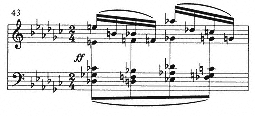
Example 10.1
Second Chamber Symphony, op. 38, 1, fourth chords at climax of A2 .
chords not directly related to the local tonic A: specifically the D7 and

A revealing point of comparison between the First and Second Chamber Symphonies is their respective treatment of quartal elements. As we recall, fourths play a prominent role in op. 9, especially at important formal junctures. We may recall too that the quartal harmonies of op. 9 tend to arise through stepwise voice-leading and that Schoenberg often seems to conceive these outwardly symmetrical formations in terms of root functions. There are no six-part quartal chords in op. 38 of the kind found in op. 9; from this point of view, the work is indeed less radical-more "regressive," in Schmidt's terms. But there are distinctly quartal elements, and the way in which they are integrated into the overall harmonic language is just as persuasive as in op. 9.
The first quartal sonority comes in m. 9, in phrase c' at the approach to the first cadence in







Example 10.2
Second Chamber Symphony, op. 38, 1, fourth chords.
Purer fourth chords are encountered at the important cadential points at the end of A and the coda, in particular at mm. 47-48 and 159-63. In the former (ex. 10.2a), the tonic is approached directly from a four-part fourth chord, which stands in for the conventional dominant. As in the climax four measures earlier, the radical nature of the cadence is muted, understated by the smooth voice-leading. The cadential passage at the end of the coda (ex. 10.2b), although apparently not composed or drafted in 1906-8, merits consideration here. The melodic figures of descending fourths are harmonized first by A minor, then by a four-part fourth chord built up from





Example 10.3
Second Chamber Symphony, op. 38, 1, recapitulation of A3 .
chords are connected clearly and conspicuously by stepwise voice-leading. Schoenberg thereby manages to achieve logical yet untraditional continuity between sonorities and also manages, as in mm. 47-48, to avoid utterly any conventional V-i approach to the tonic.
This process of voice-leading is so smooth and so idiomatic that it forces us to redefine our own normal perceptions of tonal functions. Thus, it is hard to say whether the chord in m. 163 is to be taken as a substitute dominant, because of the



Before leaving the Second Chamber Symphony, we should devote some attention to the transformations of the A section in the reprise A'. It is here that we see in especially vivid form the synthesis of sonata and ternary procedures. The moment of return in m. 95 arrives quietly, unobtrusively. The original theme, accompanied by chords at its first appearance, is now surrounded by, or enmeshed in, a contrapuntal web comprised of three other voices: a syncopated theme in the first flute; a line descending in semitones, played by the bass clarinet and the first cello; and a theme played by the viola. The viola line is based rhythmically on the second, third, and fourth measures of theme A2 (cf. mm. 12-14).
Real transposition occurs with the approach to theme A3 (ex. 10.3). In true sonata-like fashion, the theme begins (in m. 122) on




final notes lead back to






The Second String Quartet, op. 10
As is suggested by Sketchbook III (table 13), Schoenberg began work on the Second Quartet in March 1907, about seven months after making the first sketches for op. 38. Over the next year and a half, the quartet was to supplant the Chamber Symphony as the focus of his creative activities. Although the genesis of the work as a whole was protracted, Schoenberg appears to have composed the individual movements at lightning speed; such, at least, is suggested by his claim to have written "three-fourths of both the second and fourth movements of my Second String Quartet in one-and-a-half days each" (Schoenberg 1975, 55).
Schoenberg himself saw the Second Quartet as marking "the transition to my second period" (Schoenberg 1975, 86) in two particular ways. First, large, continuous structures were replaced by separate movements (something also true, as I have suggested, of op. 38): "By abandoning the one-movement form and returning . . . to the organization of four movements, I became the first composer of the period to write short compositions. Soon thereafter I wrote in the extreme short forms" (ibid., 78). Second, the quartet intimated the renunciation of tonal centers that was to characterize the works of 1909: "In the first and second movements there are many sections in which the individual parts proceed regardless of whether or not their meeting results in codified harmonies. Still, here, and also in the third and fourth movements, the key is presented distinctly at all the main dividing-points of the formal organization" (ibid., 86). As has been suggested above (and will be elaborated below), Schoenberg's second point, about the juxtaposition of key-centered and non-tonal passages, forms the basic compositional premise of the quartet as a whole. In this important sense, the Second Quartet is different from either op. 7 or op. 9, pieces for which Schoenberg had made similar claims about the individual parts moving independently of harmonic implications.
As to the first point: although the division into distinct movements is, to be sure, significant, one of the great achievements of op. 10 is precisely Schoenberg's adaptation of the long-range cyclic or recapitulatory techniques of opp. 4,
5, 7, and 9 to the separate-movement format. One of the main themes of the first-movement exposition (1b, m. 12; Appendix ex. S) is recalled near the end of the trio in the scherzo movement (m. 180), just after the renowned "O du lieber Augustin" citation. The thematic material of the third movement, a setting of Stefan George's "Litanei" in variation form, comes almost exclusively from the preceding two movements; in this sense, the movement functions as a cyclic return. The coda of the finale is clearly intended to round off the quartet as a whole. The syncopated triplet figures (cello, m. 134) recall the opening theme of the first movement. The tonal return to the key of the first movement.


The first movement of op. 10 is in outward respects a more conservative sonata form than the analogous movements of op. 7 or op. 9 (or op. 38). The exposition (mm. 1-89), development (90-145), recapitulation (146-201), and coda (202-33) are not hard to locate. (For Schoenberg's own analysis, which employs sonata form, see Rauchhaupt 1971, 43-44; see also the analysis in Whittall 1972, 20-21.) The exposition of op. 10 has the following design:
1a, m. 1
1b, m. 12
1a'/transition, m. 33
2a, m. 43
2b, m. 59
2c, m. 70
What is distinctive is the way Schoenberg manipulates the sonata structure into a technical and expressive conflict between tonal and atonal gestures, a conflict that prefigures that of the quartet as a whole. The contrast between themes, especially between 1a and 1b (and 1a and 2a, which is closely related to 1b, as will be shown below), is distinctly sharper than that between the analogous themes in op. 38 and is, indeed, perhaps more extreme than in any previous sonata form by Schoenberg.
Theme 1a (see Appendix ex. S) begins in


melodic line alone could be heard as a conventional unit in



Schoenberg's bold stroke here-one that has implications not only for sonata form but for his entire musical style-is to reverse the expected associations of tonality/consonance with stability, and of atonality/dissonance with instability. Despite its triadic orientation, theme 1a is highly unstable. It refuses to hold to its

From the viewpoint of phrase structure as well, 1a seems unstable. Outwardly, it has a two-part, antecedent-consequent structure of the kind Schoenberg himself might have analyzed as a "period" (mm. 1-7, 8-11). But the proportions and the general Stimmung are awry. The first phrase or antecedent begins with a proper two-measure unit, which is followed by a three-measure one. But the succeeding measures undermine any incipient regularity. The consequent is too short, and it is violent: instead of "completing" or complementing the antecedent, it grabs the theme and in m. 11 brings it abruptly to a halt.
The contrasting theme of the first group, 1b, presents a very different picture. It unfolds at a relatively constant tempo, which Schoenberg marks significantly as the Hauptzeitmaß, or principal tempo, almost as if what preceded is to be taken as Vorspiel. The smooth linearity of its bass line and the regularity of the melodic structure (5 + 5, mm. 12-16 and 17-21) give the theme a stability or solidity. Unlike theme 1a, 1b is accorded a full counterstatement beginning in m. 24. With its regular Hauptzeitmaß, its smooth voice-leading, and its substantial length, theme 1b, then, takes on the character of a principal or primary theme in a sonata form. In that a relatively unstable opening theme leads to a more stable second one, Schoenberg's procedure in op. 10 is analogous to that in the first movement of op. 38. But the tonal implications are now reversed. In op. 38, the reader will recall, the opening theme gives way to a firm (if temporary)


Example 10.4
Second String Quartet, op. 10, 1, comparison of themes 1b and 2a.
The approach to the second group replicates (and thus reinforces) to some extent the process of the first twelve measures of the movement. The return of 1a as a transitional element (1a'/transition) brings with it the unsteady tempo of the opening measures. In a sense this passage shows 1a in its "true" light; it is more suited to be an unstable transition than an opening theme. The transition gives way in m. 43 to Zeitmaß (presumably the same as the Hauptzeitmaß of m. 12) and to theme 2a, which is derived directly and unmistakably from 1b.
This derivation or relationship becomes clear when the two themes are super-imposed as in ex. 10.4. Both consist of two phrases (5+5 measures in 1b, 4+5 in 2a). Both begin with a

Schoenberg also plays with the formal implications of thematic groupings. In one sense, the first 43 measures present an ABA' form, a conventional arrangement within sonata traditions from Schubert onward (see, for example, the first
movement of Brahms's Violin Sonata in G Major, op. 78, or of Schoenberg's own D-Major Quartet of 1897). But the ternary design, in which the longer, more stable theme normally encloses the shorter, unstable one, does not fit or suit the thematic material in op. 10. We are thus forced, or invited, to hear beyond the 43 measures to a larger two-part design, AB A'B', in which each part begins unstably and moves to a more stable theme (Appendix ex. S). The essential identity that Schoenberg creates between the B and B' themes (respectively 1b and 2a in my sonata-form analysis) overrides the conventional sonata plan, in which we expect a distinct contrast between first group and second group. In op. 10 Schoenberg has built that contrast right into the first group.
The continuation of the second group at m. 58 (not shown in ex. S) further complicates and extends the AB A'B' design by adding a suggestion of A": the theme that begins at m. 58 ("belebend"), which can be labeled functionally as 2b, or the second idea within the second group, is in fact derived rhythmically from the second measure of theme 1a (m. 2 of the movement).[3] The derivation becomes explicit at the recapitulation, where 2b (m. 150) follows immediately upon 1a (m. 146) as part of the first group. The presence of 2b in the exposition as a developmental variant of 1a serves as a kind of complement to the relationship of 2a and 1b. In both cases, first-group material (1a and 1b) comes back more or less overtly in the second group (as 2b and 2a, respectively).
In the recapitulation, Schoenberg continues to explore the dualistic relationship between themes. At the opening of the recapitulation in m. 146, he strikingly reverses the process from the analogous part of the exposition. Theme 1a now begins in F major, the key or triad on which it fell apart upon its first appearance (m. 11); it then moves smoothly, through stepwise voice-leading to the tonic

In his own analysis of op. 10, Schoenberg suggests that theme 2a is omitted from the recapitulation (Rauchhaupt 1971, 44). But it seems clear that the passage beginning at m. 196 serves precisely a recapitulatory function and leads to the coda at the resolution to

[3] I am grateful to Julian Treves for suggesting this relationship to me.
economical recapitulatory strategy for Schoenberg, one that is also present in the finale of op. 10. The half-step figure (from mm. 43-44, but without the whole-step descent of m. 44) appears in the upper voices; the descending figure (from mm. 45-46) is in the cello. The isolation of the half-step neighbor figure helps reinforce the close identity between themes 1b and 2a.
The first movement of op. 10 calls many sonata-like precepts into question, while nevertheless adhering with relative strictness to the formal prototype. The impetuous scherzo seems to throw any such caution to the wind. It is one of the most extraordinary and unorthodox instrumental movements among Schoenberg's early works, and certainly far more radical than the scherzos in opp. 7 and 9. Elaborating the Formübersicht prepared by Erwin Stein for the Philharmonia pocket score of op. 10 (no. 229), Schmidt has divided the scherzo proper into a brief, nineteen-measure "exposition" and a "development" lasting from m. 20 to m. 97 (SW B20: 178-79). Here the use of sonata-form terminology seems to me (even with my own strong propensity to read "sonata" into instrumental movements) misleading and inappropriate. To be sure, the absence of an immediate "recapitulation," or its displacement to the return of the scherzo after the trio, would perhaps not be surprising from the composer of the First Quartet and First Chamber Symphony. But in the Stein-Schmidt scheme, the proportion of "exposition" to "development" is out of balance. Moreover, that the three basic thematic ideas in the scherzo are separated by a fermata but no "transition" suggests a formal dynamic very different from sonata form. Indeed, the process seems almost to dismiss or turn its back on the rather orthodox sonata form of the preceding movement.
The body of the scherzo consists essentially of an alternation and cumulative development of three basic thematic units, A (mm. 1-13), B (14-17), and C (17-19), which seem constantly to react to each other (see Appendix ex. T). Unit A begins with only a rhythmic figure (x) in the cello (perhaps an echo of Beethoven's equally unusual scherzo in op. 59, no. 1?). In m. 4, this figure is overlaid with two other ideas (y and z). Beginning in m. 7, the upper two parts are inverted so that the staccato z appears below the legato y (whose rhythmic profile is now varied). In unit B, the rhythmic motive x, which was deprived of any melodic shape, is now accorded one; but after three and a half measures, C seems to dismiss the preceding lyricism with a chuckle of sixteenth notes. Later in the scherzo (m. 65), C is itself transformed from its original skittish shape into a lyrical melody "mit sehr zartem Ausdruck."
In the critical report to SW (B20: 178-89). Schmidt has described in illuminating detail Schoenberg's extensive sketches and drafts for the "development" section of the scherzo (mm. 20-97). His essential point is that the various thematic units that I have called A, B, and C (and that are called Gedanken 1, 2, and 3 by Schmidt), were continuously reshuffled and recombined, almost like pieces of a

Example 10.5
Second String Quartet, op. 10, II, first sketch for scherzo theme, from Sketchbook III, p. 56.
puzzle, until the final form was reached (and indicated by Schoenberg in the sketchbook by a characteristic profusion of cross-reference symbols). The sketching process shows Schoenberg working in this movement toward a new kind, or a new degree, of developmental form.
It is worthy of notice too that according to the sequence of Sketchbook III, the scherzo was both the first movement of op. 10 to be sketched and the last to be completed (see table 13); it can thus be said to have preoccupied Schoenberg on some level throughout the eighteen-month genesis of the work (although he claims to have composed most of it in a day and a half). The first notated ideas for the quartet in Sketchbook III are contained in two sketches on p. 56 (see table 13; SW B20: 177). The first contains a single-line draft for the eighth-note motive z of theme A (ex. 10.5); it is identical to its final form except that it contains an immediate repetition of the first measure (and thus is three measures long in the sketch, rather than two as in the final version). The second appears to be a sketch for the trio and is, as Schmidt suggests, "very close to the 'O du lieber Augustin passage' in gesture and rhythmic shape" (SW B20: 177).
The first sketch is of relevance to the present study because it shows that Schoenberg's first notated idea for the Second Quartet was in the key of his previous quartet (and several other early works), D minor, and that, somewhat like the opening theme of op. 7, it seems intent on exploring the chromatic range around a D center. Indeed, this little theme can almost be taken as representative or symbolic of Schoenberg's tonal language at this time (probably early 1907). The tonic is obviously D, and it is complemented or supported by a clear dominant tone, A, as well as by two tonic-defining neighbor notes (part of the dominant chord),

The disintegration of D becomes still more extreme in the trio, which is given a key signature of D major. Here the main theme, a combination of a rapid descending figure in the violin and a lyrical rising melody in the cello (ex. 10.6), is

Example 10.6
Second String Quartet, op. 10, II, main theme of trio.
to my ear the least tonally centered of any so far in the quartet: that is, it has less audible relationship to D major than do the themes of the scherzo proper to D minor. Schoenberg refers to the violin figure of m. 98 as having "seven notes . . . because this was the form in which this theme came to mind" (Rauchhaupt 1971, 45). Indeed, in the sketches for the trio, the figure consists entirely of eighth notes, divided between two measures,




The cello theme that is placed underneath the sequence beginning in m. 100 is also extremely dissonant. Its nine notes expose eight different chromatic tones (only the

The essential dramatic scenario of the scherzo and trio of op. 10 appears, then,

Example 10.7
Second String Quartet, op. 10, II, transformation of "Augustin" theme.
to be the dissolution or evaporation of conventional tonality. This tale reaches its overtly programmatic climax at the end of the trio, in m. 160, where the musical development of the trio themes screeches to a halt and yields to the renowned quotation of "O du lieber Augustin." The intrusion of this popular song, especially of its last phrase, "Alles ist hin," serves, as is often remarked, as a kind of self-referential commentary on the distintegration of the musical language. What is perhaps not so often articulated is what Schoenberg himself points out (Rauchhaupt 1971, 45): that the liquidation or taking-apart of the "Augustin" theme in mm. 171-92 yields the principal motives of themes 1b and 2a of the first movement. Specifically (ex. 10.7), the opening neighbor-note figure, A-B-A (or



Here we have an extraordinary example of the kind of thematic transformation that we have been tracing throughout Schoenberg's early works and that is now put into the service of a programmatic statement. With the transformation of the banal, tonal street song back into the intense, dissonant thematic material of the quartet, Schoenberg seems to be saying that the step between tonality and atonality (or between consonance and dissonance), which was presented in exaggerated form in the opening segment of the first movement and then further exposed in the scherzo and trio, is in fact not so great. It is not an unbridgeable, absolute gap. This is, of course, the viewpoint repeatedly propounded by Schoenberg in his Theory of Harmony, where he argues that "dissonances are the more remote consonances of the overtone series" (Schoenberg 1978, 329).[4] Here, in the trio of
[4] This quotation comes from the crucial chapter on "non-harmonic" tones (chapter 17). See also chapter 3, "Consonance and Dissonance."
op. 10, he makes the point musically by referring back to precisely that spot in the first movement where the tonal-atonal or consonant-dissonant juxtaposition was made, in the first theme group. It is to create this association for the listener, rather than to fufill any purely "cyclic" impulse, that Schoenberg here makes reference to a theme from the first movement. Thus in this way, as in so many others, the Second Quartet makes over traditional techniques.
The apparent genesis of the last two movements of op. 10 sheds further light on the important issue of cyclicism or return in the work. According to the sequence of sketches, as well as certain notations, in Sketchbook III, the present fourth movement, "Entrückung," was originally projected to be in third position. The sketches for it are headed "III Satz Streichquartett"; they follow sketches for movements 1 and 2, and precede those for "Litanei" (see table 13). "Litanei" was thus not only the last movement conceived (although the scherzo was the last actually to be completed), but appears to have been intended as the finale, even though no sketches are marked specifically as such. Such is the reasonable speculation of Schmidt, who notes that an ordering "Entrückung"- "Litanei" would have placed the most obviously recapitulatory movement last, according to nineteenth-century tradition (SW B20: 193).
I would concur with Schmidt's interpretation of the evidence, in part because, judging by the example of Schoenberg's earlier instrumental works that have been examined in this study, we would expect him instinctively to place some kind of important large-scale return near the end of a piece. The key of "Litanei," however, which is





When he reversed the order of "Entrückung" and "Litanei," thus displacing
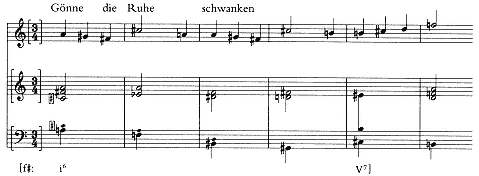
Example 10.8
Second String Quartet, op. 10, III, sketch for fourth stanza of "Litanei," from Sketchbook III, p. 108.
the most substantial cyclic return from its customary end position, Schoenberg effected a profound change not only in the shape of the quartet but in his whole conception of large-scale form. From the viewpoint of the texts alone, the decision was both significant and logical. In the final version of the quartet, the questioning, anguished persona of "Litanei" is liberated and released in "Entrückung," literally set afloat in the atmosphere. Here the "qual" (torture, anguish) of "Litanei" is completely "erloschen" (extinguished). George uses the word qual in both poems, and Schoenberg clearly picks up on the verbal association. An ordering of movements "Entrückung"-"Litanei," as intially planned, would have given a completely contrary motion, from liberation toward pain and suffering (albeit with the hope of redemption).
As is well known, Schoenberg dedicated the Second Quartet to his wife, Mathilde. The composition of the work coincided with a particularly painful point in their marriage, just after the end of Mathilde's affair with the painter Richard Gerstl (who committed suicide). Schoenberg's apparent vacillation over the ordering of the last two movements may well reflect his own emotional conflict over the Gerstl affair. From an initial pessimistic despair, from an "Entrückung" - "Litanei" ordering, he moved toward a more optimistic, life-affirming (really art-affirming) position, signified in part by the ordering "Litanei"-"Entrückung."
Although many commentators, including Schoenberg, have a tendency to speak of "shorter" forms in op. 10, the finale is, in fact, an expansive structure. Lasting almost eleven minutes, it is twice as long as any of the preceding three movements and half as long as the entire First Chamber Symphony. In its fusion of song and instrumental form, "Entrückung" is one of the masterpieces of Schoenberg's early period. As in the first movement, and as in so many other structures we have examined in this study, Schoenberg relies on sonata-like pro-
cesses to give the finale its shape. In his Formübersicht in the Philharmonic pocket score, Erwin Stein gives the large outlines of the sonata structure, which may be expanded or filled out as follows:
INSTRUMENTAL INTRODUCTION
Part I, mm. 1-9
Part II, mm. 10-15
Part III, mm. 16-21 (= transition to exposition)
EXPOSITION
Theme 1, mm. 21-26
Transition/development, mm. 27-51
Theme 2, mm. 51-66
DEVELOPMENT
Part I, mm. 67-82
Part II, mm. 83-99
REPRISE
Themes 1 and 2 combined, mm. 100-19
CODA, mm. 120-56
The renowned introduction to this movement is a masterpiece of tone painting that both illustrates the "transport" of the poem and epitomizes or captures the essential tonal-atonal conflict that lies at the basis of the quartet. The opening of the introduction is built from essentially two different melodic figures or types. The first, introduced by the instruments in rising imitation in the first measure, can be called the "floating" figure. Although if the entries come at the interval of a fifth (

The descending fifth and the open-fifth interval itself play an important role in this movement. In the introduction, they serve not only as a melodic figure, but also as closing gesture for parts I and II. Part I ends with an emphatic pizzicato G-C (m. 9); this same fifth is reiterated as a simultaneity at the end of part II (m.
15). It is then raised a half-step to



The tonic of this movement makes its first real appareance, over a dominant pedal, at the cadence in theme 1, "ich fühle luft." This theme, as suggested above, functions much like the first theme in a sonata form, essentially stable and tonally focused. It is followed by a developmental transition based entirely on motives derived from the introduction and from theme 1. In the tonal world of this movement, as in the first movement, we cannot expect the traditional harmonic markers of sonata form—that is, a clear modulation to a second key area within the exposition. Nevertheless, the entry of "ich löse mich in tönen" functions much like a second theme, except that it is still more strongly oriented around the tonic than theme 1.

The development divides into essentially two sections, of which the second, beginning at m. 83, is remarkable for having the feel of a lilting scherzo or waltz. Here Schoenberg transforms the previously angular, staccato triplets into lyrical melodic lines. The floating of the introduction has turned into a more rhythmically defined dance on the "sea of crystalline radiance."
We have looked frequently in this study at the phenomenon of recapitulation in Schoenberg's early works and have investigated some of the ways in which he manages to effect a reprise of material without any exact repetition. In the first movement of op. 10, the reader will recall, Schoenberg compressed the reprise greatly, in part by presenting the two halves of theme 2a in counterpoint with each other. This kind of compression is carried even further in the finale. Here Schoenberg brings themes 1 and 2 together contrapuntally. The voice part at "ich
[5] Forte's analysis of the opening of this movement (1978, 164-71) contains many persuasive observations on atonal procedures, but tends to disregard the tonal implications and gestures that are so clearly part of Schoenberg's compositional strategy. In his zeal to attribute "set consciousness" to Schoenberg, Forte downplays the role of conventional tonal structures by referring to them in quotation marks ("descending fifths," "augmented triads," and the like), as if such gestures were unwelcome foreign objects within the world of pitch-class sets, rather than an integral part of Schoenberg's musical language. Forte also analyzes the pitch content of theme 1, "ich fühle luft" (set 4-23), with no reference to the harmonic underpinning that is an essential element (1978, 165). A more sensitive, tonally oriented analysis of this movement is Ballan 1986, 190-205. See also Whittall 1972, 23-24.
bin ein funke" is a reprise of theme 1, first heard at "ich fühle luft." Surrounding this theme above (first violin) and below, or roughly in the same register (second violin), is theme 2 in octaves. Also brought in from theme 2 here is the bass line ascending stepwise from the tonic


Now begins perhaps the most astonishing aspect of the reprise: theme 1, at its original pitch level (D-G-A-C), appears in augmentation in the bass underneath the climactic final words "heilige stimme." A sequential repetition begins in m. 114 on




The moving instrumental coda to the movement serves to balance the introduction and, as has been suggested, to round off the entire quartet. If the introduction can be said to have stressed "floating" and atonality, the coda moves in the other direction, toward tonal resolution. Here we get the longest sustained tonic and dominant phrases in the movement. The final cadence of the work is, however, made not from the dominant, but from the trichord


The cadential resolution is combined with or accompanied by a reference to the initial "floating" motive of the introduction, and as such it seems to epitomize the remarkable blend of traditional tonal procedures and newer atonal ones in this quartet. From the high




is so right. At this point, critical analysis must leave off and mute admiration take over.
In his writings Schoenberg attributes to his subconscious, the "Supreme Commander," many aspects of the composition of his works, such as elegant motivic and thematic relations. In the final stanza of "Entrückung," we encounter an artist who has in effect placed himself in the hands of, or made himself the vehicle of, a "heilige stimme" beyond his own direct, conscious control. It is clear from the music he wrote for this movement that the "stimme" was now leading Schoenberg away from many of the compositional preoccupations traced in this study. Consideration of op. 10, then, serves as an appropriate end point.



